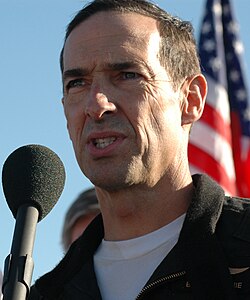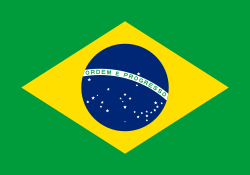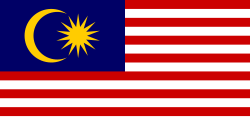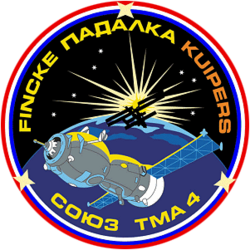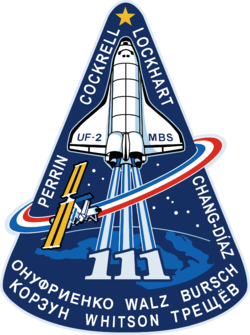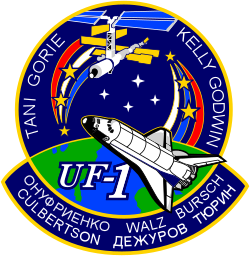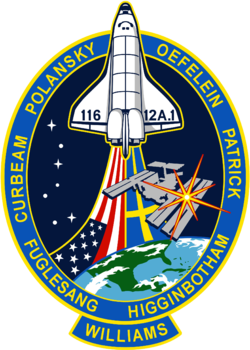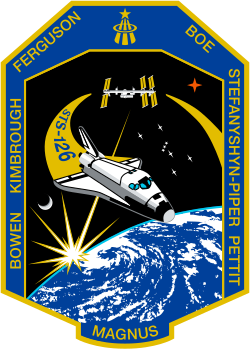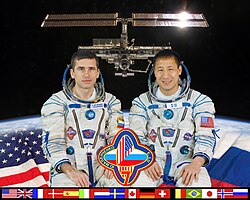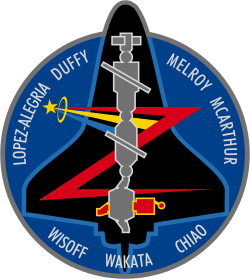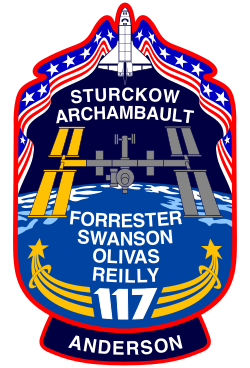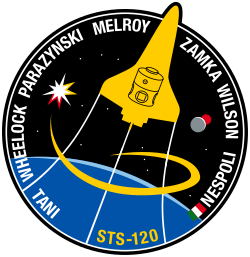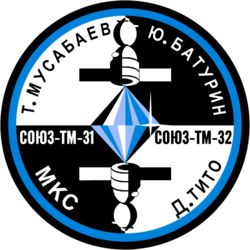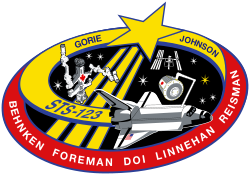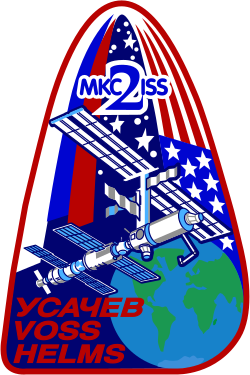Seznam pilotovaných vesmírných letů 2000–2009

Seznam pilotovaných letů s lidskou posádkou v letech 2000–2009 zahrnuje 58 orbitálních a 3 suborbitální pilotované kosmické lety. V uvedeném období proběhla poslední mise na stanici Mir, lety k Mezinárodní vesmírné stanici, nehoda raketoplánu Columbia, lety čínských kosmických lodí Šen-čou a první soukromé suborbitální lety.
Roku 2000 začala nová etapa kosmických letů – v červnu odletem 28. expedice skončilo čtrnáctileté osídlení stanice Mir. Naopak začátkem listopadu na Mezinárodní vesmírnou stanici (ISS) přiletěla Expedice 1, čímž začalo trvalé osídlení nové stanice. Výměna posádek a výstavba ISS byly náplní většiny ruských a amerických pilotovaných letů následujících let. Výjimkou byly jen čtyři samostatné mise amerických raketoplánů – let STS-99 roku 2000, dvě servisní mise k Hubbleovu vesmírnému dalekohledu a let STS-107 raketoplánu Columbia, který při přistání lodi skončil zničením raketoplánu a smrtí posádky. Zatímco americká vesmírná agentura NASA používala k letům do vesmíru raketoplány Space Shuttle, ruský Roskosmos disponoval kosmickými loděmi Sojuz.
V prvním desetiletí 21. století proběhly také první tři čínské pilotované kosmické lety – mise Šen-čou 5, 6 a 7 – a první tři suborbitální lety soukromé kosmické lodě – mise SpaceShipOne 15P až 17P.
Seznam letů
- Červeně označené lety jsou lety, při kterých se stala katastrofa s následkem smrti posádky.
- Zeleně označené lety jsou suborbitální lety.
| Pokračování ze seznamu pilotovaných vesmírných letů 1987–1999 | ||||||
|---|---|---|---|---|---|---|
| Znak mise | Loď | Mise, posádka | Foto posádky | Cíl letu | Shrnutí mise | Ref. |
| Rok 2000 | ||||||
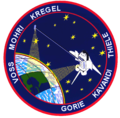 | Endeavour Start: 11. února 2000 Přistání: 22. února 2000 | STS-99 |  | Experimenty na oběžné dráze Země | Trojrozměrné radiolokační interferometrické mapování zemského povrchu a další experimenty. | [1][2] |
| Sojuz TM-30 Start: 4. dubna 2000 Přistání: 16. června 2000 | 28. základní expedice (EO-28) |  | Vesmírná stanice Mir | Servisní mise, jeden výstup do vesmíru, poslední výprava ke stanici Mir. | [3] | |
 | Atlantis Start: 19. května 2000 Přistání: 29. května 2000 | STS-101 | 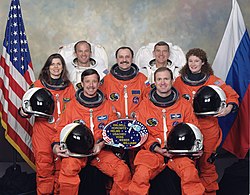 | Mezinárodní vesmírná stanice (ISS) | Zásobovací mise, servisní činnosti, zvýšení oběžné dráhy komplexu, jeden výstup do vesmíru. | [4][5] |
 | Atlantis Start: 8. září 2000 Přistání: 20. září 2000 | STS-106 | 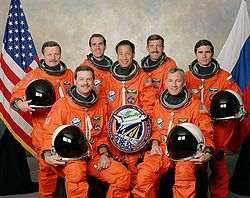 | Mezinárodní vesmírná stanice (ISS) | Zásobovací mise, jeden kosmický výstup. | [6][7] |
 | Discovery Start: 11. října 2000 Přistání: 24. října 2000 | STS-92 |  | Mezinárodní vesmírná stanice (ISS) | Montážní mise, připojení příhradové konstrukce Z1, čtyři výstupy do vesmíru. | [8][9] |
 | Sojuz TM-31 Start: 31. října 2000 Přistání: 6. května 2001 |  | Mezinárodní vesmírná stanice (ISS) | Přílet posádky Expedice 1, která poprvé dlouhodobě zabydlela stanici. Posádka Expedice 1 se na Zemi vrátila v březnu 2001 raketoplánem Discovery při misi STS-102. Sojuz TM-31 byl ke stanici půl roku připojen jako záchranný člun, na Zemi se vrátil s 1. návštěvní expedicí v květnu 2001. | [10] | |
 | Endeavour Start: 30. listopadu 2000 Přistání: 11. prosince 2000 | STS-97 |  | Mezinárodní vesmírná stanice (ISS) | Montážní mise, připojení příhradové konstrukce P6 se solárními panely, tři výstupy do vesmíru. | [11][12] |
| Rok 2001 | ||||||
 | Atlantis Start: 7. února 2001 Přistání: 20. února 2001 | STS-98 |  | Mezinárodní vesmírná stanice (ISS) | Montážní mise, připojení laboratoře Destiny, tři výstupy do vesmíru. | [13] |
  | Discovery Start: 8. března 2001 Přistání: 21. března 2001 | STS-102 | 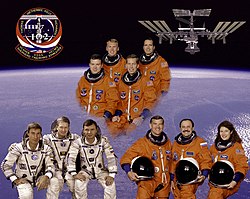 | Mezinárodní vesmírná stanice (ISS) | Použití transportního modulu MPLM Leonardo, přílet posádky Expedice 2 na stanici a návrat posádky Expedice 1 na Zemi, dva výstupy do vesmíru. Expedice 2 přistála v srpnu 2001 při misi STS-105 raketoplánu Discovery. | [14] |
 | Endeavour Start: 19. dubna 2001 Přistání: 1. května 2001 | STS-100 |  | Mezinárodní vesmírná stanice (ISS) | Použití transportního modulu MPLM Raffaello, instalace staničního manipulátoru Canadarm2, dva výstupy do vesmíru. | [15] |
 | Sojuz TM-32 Start: 28. dubna 2001 Přistání: 31. října 2001 | 1. návštěvní expedice (EP-1) |  | Mezinárodní vesmírná stanice (ISS) | Přílet 1. návštěvní expedice na ISS, v posádce byl i první vesmírný turista Dennis Tito. Celá tříčlenná posádka se po týdnu vrátila Sojuzem TM-31. Sojuz TM-32 zůstal u stanice půl roku připojený jako záchranný člun a na Zemi se vrátil v říjnu 2011 s posádkou 2. návštěvní expedice. | [16][17] |
 | Atlantis Start: 12. července 2001 Přistání: 25. července 2001 | STS-104 |  | Mezinárodní vesmírná stanice (ISS) | Montážní mise, instalace přechodové komory Quest, tři výstupy do vesmíru. | [18] |
 | Discovery Start: 10. srpna 2001 Přistání: 22. srpna 2001 | STS-105 |  | Mezinárodní vesmírná stanice (ISS) | Zásobovací mise, použití transportního modulu MPLM Leonardo, přílet posádky Expedice 3 na stanici a návrat posádky Expedice 2 na Zemi, dva výstupy do vesmíru. Posádka Expedice 3 se ze stanice vrátila v prosinci 2001 raketoplánem Endeavour při misi STS-108. | [19] |
 | Sojuz TM-33 Start: 21. října 2001 Přistání: 5. května 2002 | 2. návštěvní expedice (EP-2) |  | Mezinárodní vesmírná stanice (ISS) | Přílet 2. návštěvní expedice na ISS. Celá tříčlenná posádka se po 9 dnech a 18 hodinách vrátila Sojuzem TM-32 na Zemi. Sojuz TM-33 zůstal u stanice připojen půl roku jako záchranný člun, na Zem se vrátil v květnu 2002 s posádkou 3. návštěvní expedice. | [20][21] |
  | Endeavour Start: 5. prosince 2001 Přistání: 17. prosince 2001 | STS-108 |  | Mezinárodní vesmírná stanice (ISS) | Zásobovací mise, použití transportního modulu MPLM Raffaello, přílet posádky Expedice 4 na ISS, návrat posádky Expedice 3 na Zemi, jeden kosmický výstup. Posádka Expedice 4 se ze stanice vrátila v červnu 2002 raketoplánem Endeavour při misi STS-111. | [22] |
| Rok 2002 | ||||||
 | Columbia Start: 1. března 2002 Přistání: 12. března 2002 | STS-109 |  | Hubbleův vesmírný dalekohled (HST) | Čtvrtá servisní mise raketoplánu k Hubbleovu vesmírnému dalekohledu. Výměna obou velkých solárních panelů dalekohledu, výměna energetické jednotky PCU (Power Control Unit), výměna kamery FOC (Faint Object Camera) za ACS (Advanced Camera for Surveys) a doplnění chladicího systému, pět výstupů do otevřeného prostoru. | [23] |
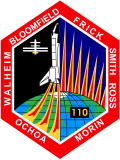 | Atlantis Start: 8. dubna 2002 Přistání: 19. dubna 2002 | STS-110 |  | Mezinárodní vesmírná stanice (ISS) | Montážní mise k ISS, připojení příhradové konstrukce S0, čtyři výstupy do vesmíru. | [24] |
 | Sojuz TM-34 Start: 25. dubna 2002 Přistání: 10. listopadu 2002 | 3. návštěvní expedice (EP-3) | 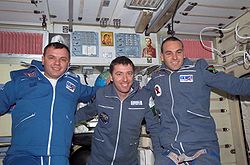 | Mezinárodní vesmírná stanice (ISS) | Přílet 3. návštěvní expedice s vesmírným turistou Markem Shuttleworthem na ISS. Celá tříčlenná posádka se po 8 dnech vrátila Sojuzem TM-33 na Zemi. Sojuz TM-34 zůstal u stanice připojen půl roku jako záchranný člun, na Zem se vrátil v listopadu 2002 s posádkou 4. návštěvní expedice. | [25][26] |
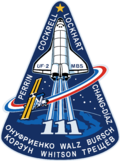  | Endeavour Start: 5. června 2002 Přistání: 19. června 2002 | STS-111 | 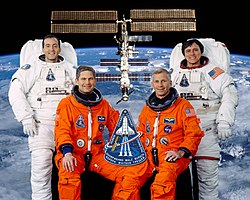 | Mezinárodní vesmírná stanice (ISS) | Zásobovací mise, použití transportního modulu MPLM Leonardo, přílet posádky Expedice 5 na ISS, návrat posádky Expedice 4 na Zemi, tři kosmické výstupy, připojení mobilního systému pro Canadarm2. Posádka Expedice 5 se ze stanice vrátila v prosinci 2002 raketoplánem Endeavour při misi STS-113. | [27] |
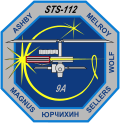 | Atlantis Start: 7. října 2002 Přistání: 18. října 2002 | STS-112 | 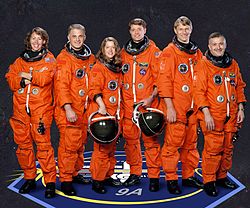 | Mezinárodní vesmírná stanice (ISS) | Montážní mise k ISS, připojení příhradové konstrukce S1, tři výstupy do vesmíru. | [28] |
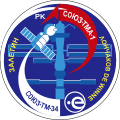 | Sojuz TMA-1 Start: 30. října 2002 Přistání: 4. května 2003 | 4. návštěvní expedice (EP-4) |  | Mezinárodní vesmírná stanice (ISS) | Přílet 4. návštěvní expedice na ISS. Celá tříčlenná posádka se po týdnu vrátila Sojuzem TM-34 na Zemi. Sojuz TMA-1 zůstal u stanice připojen půl roku jako záchranný člun, na Zem se vrátil v květnu 2003 s posádkou Expedice 6. | [29][30] |
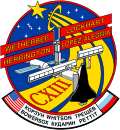 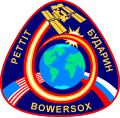 | Endeavour Start: 24. listopadu 2002 Přistání: 7. prosince 2002 | STS-113 |  | Mezinárodní vesmírná stanice (ISS) | Montážní mise, připojení příhradové konstrukce P1, tři výstupy do vesmíru. Přílet posádky Expedice 6 na ISS, návrat posádky Expedice 5 na Zemi. Posádka Expedice 6 se ze stanice vrátila v květnu 2003 Sojuzem TMA-1. | [31] |
| Rok 2003 | ||||||
 | Columbia Start: 16. ledna 2003 Havárie: 1. února 2003 | STS-107 |  | Experimenty na oběžné dráze Země | Experimenty s mikrogravitací, lékařské, technologické a materiálové experimenty na oběžné dráze, využití laboratoře Spacehab. Let skončil 1. února 2003 havárií a ztrátou stroje i s celou posádkou během přistávacího manévru. | [32] |
 | Sojuz TMA-2 Start: 28. dubna 2003 Přistání: 28. října 2003 | Mezinárodní vesmírná stanice (ISS) | Přílet posádky Expedice 7. Sojuz TMA-2 zůstal u stanice připojen půl roku jako záchranný člun, na Zem se vrátil v říjnu 2003 se stejnou posádkou, ke které se připojil člen 5. návštěvní expedice Pedro Duque. | [33] | ||
| Šen-čou 5 Start: 15. října 2003 Přistání: 15. října 2003 |  | Oběžná dráha Země | První pilotovaný let Čínské lidové republiky. | [34] | ||
 | Sojuz TMA-3 Start: 18. října 2003 Přistání: 30. dubna 2004 | Expedice 8 |  | Mezinárodní vesmírná stanice (ISS) | Přílet posádky Expedice 8 a 5. návštěvní expedice. Duque se vrátil po několika dnech s posádkou Expedice 7 v Sojuzu TMA-2. Sojuz TMA-3 zůstal u stanice připojen půl roku jako záchranný člun, na Zem se vrátil v dubnu 2004 s posádkou Expedice 8, ke které se připojil člen 6. návštěvní expedice André Kuipers. | [35][36] |
| Rok 2004 | ||||||
 | Sojuz TMA-4 Start: 19. dubna 2004 Přistání: 24. října 2004 | Expedice 9 | 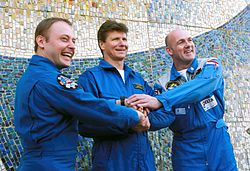 | Mezinárodní vesmírná stanice (ISS) | Přílet posádky Expedice 9 a 6. návštěvní expedice. Kuipers se vrátil po několika dnech s posádkou Expedice 8 v Sojuzu TMA-3. Sojuz TMA-4 zůstal u stanice připojen půl roku jako záchranný člun, na Zem se vrátil v říjnu 2004 s posádkou Expedice 9, ke které se připojil člen 7. návštěvní expedice Jurij Šargin. | [37][38] |
| SpaceShipOne Start: 21. června 2004 Přistání: 21. června 2004 | SpaceShipOne let 15P |  | Suborbitální let | První let do vesmíru soukromou kosmickou lodí v rámci soutěže Ansari X Prize. | [39] | |
| SpaceShipOne Start: 29. září 2004 Přistání: 29. září 2004 | SpaceShipOne let 16P |  | Suborbitální let | Druhý let do vesmíru soukromou kosmickou lodí v rámci soutěže Ansari X Prize. | [39] | |
| SpaceShipOne Start: 4. října 2004 Přistání: 4. října 2004 | SpaceShipOne let 17P | (c) Photograph by D Ramey Logan, CC BY-SA 3.0 | Suborbitální let | Třetí let do vesmíru soukromou kosmickou lodí v rámci soutěže Ansari X Prize, získání ceny. | [39] | |
 | Sojuz TMA-5 Start: 14. října 2004 Přistání: 24. dubna 2005 | Expedice 10 | 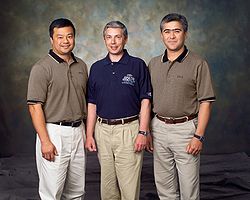 | Mezinárodní vesmírná stanice (ISS) | Přílet posádky Expedice 10 a 7. návštěvní expedice. Šargin se vrátil po několika dnech s posádkou Expedice 9 v Sojuzu TMA-4. Sojuz TMA-5 zůstal u stanice připojen půl roku jako záchranný člun, na Zem se vrátil v dubnu 2005 s posádkou Expedice 10, ke které se připojil člen 8. návštěvní expedice Roberto Vittori. | [40][41] |
| Rok 2005 | ||||||
| Sojuz TMA-6 Start: 15. dubna 2005 Přistání: 11. října 2005 | Expedice 11 | Mezinárodní vesmírná stanice (ISS) | Přílet posádky Expedice 11 a 8. návštěvní expedice. Vittori se vrátil po několika dnech s posádkou Expedice 10 v Sojuzu TMA-5. Sojuz TMA-6 zůstal u stanice připojen půl roku jako záchranný člun, na Zem se vrátil v říjnu 2005 s posádkou Expedice 11, ke které se připojil člen 9. návštěvní expedice vesmírný turista Gregory Olsen. | [42][43] | ||
 | Discovery Start: 26. července 2005 Přistání: 9. srpna 2005 | STS-114 |  | Mezinárodní vesmírná stanice (ISS) | Zásobovací let, obnovení letů raketoplánů po havárii raketoplánu Columbia v roce 2003, použití transportního modulu MPLM Raffaello, tři výstupy do vesmíru. | [44] |
| Sojuz TMA-7 Start: 1. října 2005 Přistání: 8. dubna 2006 | Expedice 12 |  | Mezinárodní vesmírná stanice (ISS) | Přílet posádky Expedice 12 a 9. návštěvní expedice. Vesmírný turista Gregory Olsen se vrátil po několika dnech s posádkou Expedice 11 v Sojuzu TMA-6. Sojuz TMA-7 zůstal u stanice připojen půl roku jako záchranný člun, na Zem se vrátil v dubnu 2006 s posádkou Expedice 12, ke které se připojil člen 10. návštěvní expedice Marcos Pontes. | [45][46] | |
| Šen-čou 6 Start: 12. října 2005 Přistání: 16. října 2005 | Oběžná dráha Země | Druhý čínský pilotovaný let, testy skafandrů, experimenty na oběžné dráze. | [47] | |||
| Rok 2006 | ||||||
| Sojuz TMA-8 Start: 30. března 2006 Přistání: 29. září 2006 | Expedice 13 |  | Mezinárodní vesmírná stanice (ISS) | Přílet posádky Expedice 13 a 10. návštěvní expedice. Marcos Pontes se vrátil po několika dnech s posádkou Expedice 12 v Sojuzu TMA-7. Sojuz TMA-8 zůstal u stanice připojen půl roku jako záchranný člun, na Zem se vrátil v září 2006 s posádkou Expedice 13, ke které se připojila členka 11. návštěvní expedice kosmická turistka Anúše Ansáríová. | [48][49] | |
 | Discovery Start: 4. července 2006 Přistání: 17. července 2006 | STS-121 | 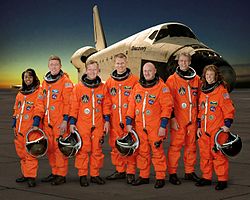 | Mezinárodní vesmírná stanice (ISS) | Zásobovací mise, prověření konstrukčních změn v tepelné izolaci odhazovací nádrže ET, použití transportního modulu MPLM Leonardo, přílet Reitera do posádky Expedice 13, tři výstupy do vesmíru. | [50] |
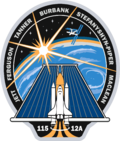 | Atlantis Start: 9. září 2006 Přistání: 21. září 2006 | STS-115 |  | Mezinárodní vesmírná stanice (ISS) | Montážní mise, připojení příhradové konstrukce P3/P4 včetně solárních panelů, kontrola raketoplánu z ISS, tři kosmické výstupy. | [51] |
| Sojuz TMA-9 Start: 18. září 2006 Přistání: 21. dubna 2007 | Expedice 14 |  | Mezinárodní vesmírná stanice (ISS) | Přílet posádky 11. návštěvní expedice a dvou členů Expedice 14. Kosmická turistka Anúše Ansáríová se vrátila po několika dnech s posádkou Expedice 13 v Sojuzu TMA-8. Sojuz TMA-9 zůstal u stanice připojen půl roku jako záchranný člun, na Zem se vrátil v dubnu 2007 s posádkou Expedice 14, ke které se připojil člen 12. návštěvní expedice kosmický turista Charles Simonyi. | [52][53] | |
 | Discovery Start: 10. prosince 2006 Přistání: 22. prosince 2006 | STS-116 | 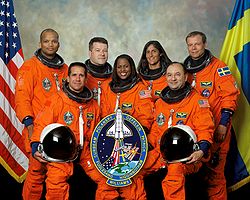 | Mezinárodní vesmírná stanice (ISS) | Montážní mise, připojení příhradové konstrukce P5, čtyři výstupy do vesmíru. Výměna Reitera s Williamsovou v posádce Expedice 14. | [54] |
| Rok 2007 | ||||||
| Sojuz TMA-10 Start: 7. dubna 2007 Přistání: 21. října 2007 | Expedice 15 |  | Mezinárodní vesmírná stanice (ISS) | Přílet posádky 12. návštěvní expedice a dvou členů Expedice 15. Kosmický turista Charles Simonyi se vrátil po několika dnech s posádkou Expedice 14 v Sojuzu TMA-9. Sojuz TMA-10 zůstal u stanice připojen půl roku jako záchranný člun, na Zem se vrátil v říjnu 2007 s dvěma kosmonauty z Expedice 15, ke kterým se připojil člen 13. návštěvní expedice Sheikh Muszaphar Shukor. | [55][56] | |
 | Atlantis Start: 8. června 2007 Přistání: 22. června 2007 | STS-117 | 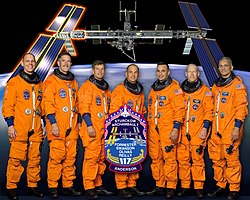 | Mezinárodní vesmírná stanice (ISS) | Montážní mise, připojení příhradové konstrukce S3/S4 včetně solárních panelů, čtyři výstupy do vesmíru. Výměna Williamsové s Andersonem v posádce Expedice 15. | [57] |
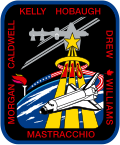 | Endeavour Start: 8. srpna 2007 Přistání: 21. srpna 2007 | STS-118 |  | Mezinárodní vesmírná stanice (ISS) | Montážní mise, připojení příhradové konstrukce S5, čtyři výstupy do vesmíru. | [58] |
| Sojuz TMA-11 Start: 10. října 2007 Přistání: 19. dubna 2008 | Expedice 16 |  | Mezinárodní vesmírná stanice (ISS) | Přílet posádky 13. návštěvní expedice a dvou členů Expedice 16. Sheikh Muszaphar Shukor se vrátil po několika dnech s posádkou Expedice 15 v Sojuzu TMA-10. Sojuz TMA-11 zůstal u stanice připojen půl roku jako záchranný člun, na Zem se vrátil v dubnu 2008 s dvěma kosmonauty z Expedice 16, ke kterým se připojila členka 14. návštěvní expedice I So-jon. | [59][60] | |
 | Discovery Start: 23. října 2007 Přistání: 7. listopadu 2007 | STS-120 | 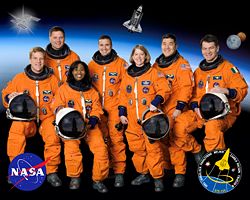 | Mezinárodní vesmírná stanice (ISS) | Montážní mise, instalace modulu Harmony, přemístění příhradové konstrukce P6, pět výstupů do vesmíru. Výměna Andersona s Tanim v posádce Expedice 16. | [61] |
| Rok 2008 | ||||||
 | Atlantis Start: 7. února 2008 Přistání: 20. února 2008 | STS-122 |  | Mezinárodní vesmírná stanice (ISS) | Montážní mise, instalace evropské laboratoře Columbus, tři výstupy do vesmíru. Výměna Taniho s Eyhartsem v posádce Expedice 16. | [62] |
 | Endeavour Start: 11. března 2008 Přistání: 27. března 2008 | STS-123 | 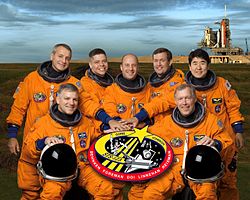 | Mezinárodní vesmírná stanice (ISS) | Montážní mise, instalace Kibō - experimentálního logistického modulu a dvouramenného robotického telemanipulátoru SPDM, pět výstupů do vesmíru. Výměna Eyhartse s Reismanem v posádce Expedice 16. | [63] |
| Sojuz TMA-12 Start: 8. dubna 2008 Přistání: 24. října 2008 | Expedice 17 |  | Mezinárodní vesmírná stanice (ISS) | Přílet posádky 14. návštěvní expedice a dvou členů Expedice 17. I So-jon se vrátila po několika dnech s posádkou Expedice 16 v Sojuzu TMA-11. Sojuz TMA-12 zůstal u stanice připojen půl roku jako záchranný člun, na Zem se vrátil v říjnu 2008 s dvěma kosmonauty z Expedice 17, ke kterým se připojil člen 15. návštěvní expedice kosmický turista Richard Garriott. | [64][65] | |
 | Discovery Start: 31. května 2008 Přistání: 14. června 2008 | STS-124 | 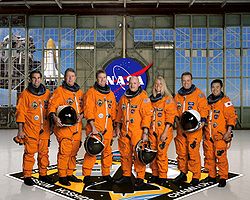 | Mezinárodní vesmírná stanice (ISS) | Montážní mise, připojení přetlakového modulu japonské laboratoře Kibó, tři výstupy do vesmíru. Výměna Reismana s Chamitoffem v posádce Expedice 17. | [66] |
| Šen-čou 7 Start: 25. září 2008 Přistání: 28. září 2008 | Šen-čou 7 | Oběžná dráha Země | Třetí čínský pilotovaný let, první čínský výstup do vesmíru. | [67] | ||
| Sojuz TMA-13 Start: 12. října 2008 Přistání: 8. dubna 2009 | Expedice 18 | 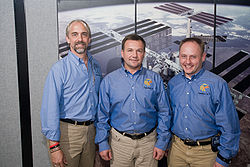 | Mezinárodní vesmírná stanice (ISS) | Přílet posádky 15. návštěvní expedice a dvou členů Expedice 18. Richard Garriott se vrátil po několika dnech s posádkou Expedice 17 v Sojuzu TMA-12. Sojuz TMA-13 zůstal u stanice připojen půl roku jako záchranný člun, na Zem se vrátil v dubnu 2009 s dvěma kosmonauty z Expedice 18, ke kterým se připojil člen 16. návštěvní expedice kosmický turista Charles Simonyi. | [68][69] | |
 | Endeavour Start: 15. listopadu 2008 Přistání: 30. listopadu 2008 | STS-126 |  | Mezinárodní vesmírná stanice (ISS) | Doplnění zásob a výbavy stanice, údržba a oprava rotačních spojů SARJ (Solar Alpha Rotary Joint), čtyři výstupy do vesmíru. Výměna Chamitoffa s Magnusovou v posádce Expedice 18. | [70] |
| Rok 2009 | ||||||
 | Discovery Start: 15. března 2009 Přistání: 28. března 2009 | STS-119 | 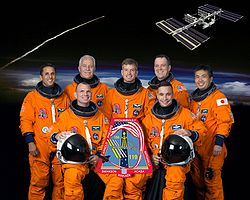 | Mezinárodní vesmírná stanice (ISS) | Montážní mise, montáž nosníku S6 se solárními panely a radiátory, tři výstupy do vesmíru. Výměna Magnusové s Wakatou v posádce Expedice 18. | [71] |
| Sojuz TMA-14 Start: 26. března 2009 Přistání: 11. října 2009 | Expedice 19/20 |  | Mezinárodní vesmírná stanice (ISS) | Přílet posádky 16. návštěvní expedice a dvou členů Expedice 19. Kosmický turista Charles Simonyi se vrátil po několika dnech s posádkou Expedice 18 v Sojuzu TMA-13. Sojuz TMA-14 zůstal u stanice připojen půl roku jako záchranný člun, na Zem se vrátil v říjnu 2009 s dvěma kosmonauty z Expedice 20, ke kterým se připojil člen 17. návštěvní expedice kosmický turista Guy Laliberté. | [72][73] | |
 | Atlantis Start: 11. května 2009 Přistání: 24. května 2009 | STS-125 |  | Hubbleův vesmírný dalekohled (HST) | Servisní mise Hubbleova vesmírného dalekohledu, vynesení HST na jeho novou dráhu, instalace nových baterií a zajištění životnosti HST minimálně do roku 2013. | [74] |
| Sojuz TMA-15 Start: 27. května 2009 Přistání: 1. prosince 2009 |  | Mezinárodní vesmírná stanice (ISS) | Přílet druhé poloviny posádky Expedice 20, zvýšení počtu členů posádky ISS na šest. Sojuz TMA-15 zůstal u stanice připojen půl roku jako záchranný člun, na Zem se vrátil v prosinci 2009 se stejnou posádkou. | [75] | ||
 | Endeavour Start: 15. července 2009 Přistání: 31. července 2009 | STS-127 |  | Mezinárodní vesmírná stanice (ISS) | Servisní mise, přivezení a montáž částí japonského modulu Kibó (Exposed Facility a Logistics Module Exposed Section), pět výstupů do vesmíru. Výměna Wakaty s Koprou v posádce Expedice 20. | [76] |
 | Discovery Start: 29. srpna 2009 Přistání: 12. září 2009 | STS-128 | 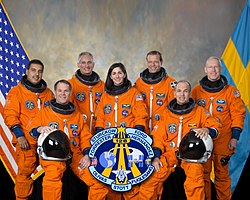 | Mezinárodní vesmírná stanice (ISS) | Zásobovací mise, použití transportního modulu MPLM Leonardo, tři výstupy do vesmíru. Výměna Kopry se Stottovou v posádce Expedice 20. | [77] |
| Sojuz TMA-16 Start: 30. září 2009 Přistání: 18. března 2010 | Expedice 21/22 |  | Mezinárodní vesmírná stanice (ISS) | Přílet posádky 17. návštěvní expedice a dvou členů Expedice 21. Kosmický turista Guy Laliberté se vrátil po několika dnech s posádkou Expedice 20 v Sojuzu TMA-14. Sojuz TMA-16 zůstal u stanice připojen půl roku jako záchranný člun, na Zem se vrátil v březnu 2010 s dvěma kosmonauty z Expedice 22. | [78][79] | |
 | Atlantis Start: 16. listopadu 2009 Přistání: 27. listopadu 2009 | STS-129 | 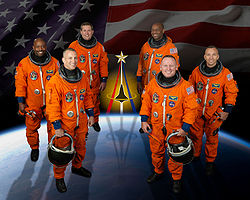 | Mezinárodní vesmírná stanice (ISS) | Zásobovací mise, doprava zásob a náhradních dílů na stanici, příprava ISS na přílet nového modulu Tranquility (Node 3), tři výstupy do vesmíru. Návrat členky Expedice 21 Nicole Stottové na Zemi. | [80] |
| Sojuz TMA-17 Start: 20. prosince 2009 Přistání: 2. června 2010 |  | Mezinárodní vesmírná stanice (ISS) | Přílet poloviny posádky Expedice 22. Sojuz TMA-17 zůstal u stanice připojen půl roku jako záchranný člun, na Zem se vrátil v červnu 2010 se stejnou posádkou. | [81] | ||
| Pokračování na seznamu pilotovaných vesmírných letů 2010–2019 | ||||||
Odkazy
Reference
- ↑ HOLUB, Aleš. MEK. Malá encyklopedie kosmonautiky [online]. Rev. 2000-3-2 [cit. 2011-07-20]. Kapitola STS-99 En/F-14. Dále jen Holub. Dostupné online.
- ↑ DUMOULIN, Jim. STS-99 (97) [online]. NASA, rev. 2001-6-29 [cit. 2011-08-10]. Dostupné v archivu pořízeném dne 2008-05-01. (anglicky)
- ↑ Holub. Rev. 2001-11-4 [cit. 2011-07-20]. Kapitola Sojuz TM-30.
- ↑ Holub. Rev. 2000-6-5 [cit. 2011-07-20]. Kapitola STS-101 At/F-21.
- ↑ DUMOULIN, Jim. STS-101 (98) [online]. NASA, rev. 2001-6-29 [cit. 2011-08-10]. Dostupné v archivu pořízeném dne 2012-07-28. (anglicky)
- ↑ Holub. Rev. 2000-9-21 [cit. 2011-07-20]. Kapitola STS-106 At/F-22.
- ↑ DUMOULIN, Jim. STS-106 (99) [online]. NASA, rev. 2001-6-29 [cit. 2011-08-10]. Dostupné v archivu pořízeném dne 2010-08-13. (anglicky)
- ↑ Holub. Rev. 2000-10-25 [cit. 2011-07-20]. Kapitola STS-92 Di/F-28.
- ↑ DUMOULIN, Jim. STS-92 (100) [online]. NASA, rev. 2001-6-29 [cit. 2011-08-10]. Dostupné v archivu pořízeném dne 2011-03-05. (anglicky)
- ↑ Holub. Rev. 2000-11-4 [cit. 2011-07-20]. Kapitola Sojuz TM-31.
- ↑ Holub. Rev. 2001-2-5 [cit. 2011-07-20]. Kapitola STS-97 En/F-15.
- ↑ DUMOULIN, Jim. STS-97 (101) [online]. NASA, rev. 2001-6-29 [cit. 2011-08-10]. Dostupné v archivu pořízeném dne 2007-12-31. (anglicky)
- ↑ DUMOULIN, Jim. STS-98 (102) [online]. NASA, rev. 2001-7-25 [cit. 2011-08-10]. Dostupné v archivu pořízeném dne 2013-08-30. (anglicky)
- ↑ DUMOULIN, Jim. STS-102 (103) [online]. NASA, rev. 2001-7-25 [cit. 2011-08-10]. Dostupné v archivu pořízeném dne 2016-06-10. (anglicky)
- ↑ DUMOULIN, Jim. STS-100 (104) [online]. NASA, rev. 2001-7-25 [cit. 2011-08-10]. Dostupné v archivu pořízeném dne 2007-09-11. (anglicky)
- ↑ Holub. Rev. 2001-11-4 [cit. 2011-10-03]. Kapitola Sojuz TM-32.
- ↑ Expedition 2 (ISS-2) – The First Russian Visiting Crew [online]. RKK Energia [cit. 2019-03-09]. Dostupné v archivu pořízeném dne 2017-09-10. (anglicky)
- ↑ DUMOULIN, Jim. STS-104 (105) [online]. NASA, rev. 2001-8-1 [cit. 2011-08-10]. Dostupné v archivu pořízeném dne 2016-08-10. (anglicky)
- ↑ DUMOULIN, Jim. STS-105 (106) [online]. NASA, rev. 2001-10-2 [cit. 2011-08-10]. Dostupné v archivu pořízeném dne 2016-07-24. (anglicky)
- ↑ Holub. Rev. 2002-5-6 [cit. 2011-10-03]. Kapitola Sojuz TM-33.
- ↑ Expedition 3 (ISS-3) – Second Russian Visiting Crew [online]. RKK Energia [cit. 2019-03-09]. Dostupné v archivu pořízeném dne 2019-07-13. (anglicky)
- ↑ DUMOULIN, Jim. STS-108 (107) [online]. NASA, rev. 2001-12-18 [cit. 2011-08-10]. Dostupné v archivu pořízeném dne 2010-11-19. (anglicky)
- ↑ DUMOULIN, Jim. STS-109 (108) [online]. NASA, rev. 2002-4-1 [cit. 2011-08-10]. Dostupné v archivu pořízeném dne 2017-03-18. (anglicky)
- ↑ DUMOULIN, Jim. STS-110 (109) [online]. NASA, rev. 2002-5-7 [cit. 2011-08-10]. Dostupné v archivu pořízeném dne 2016-06-10. (anglicky)
- ↑ Holub. Rev. 2002-11-10 [cit. 2011-10-03]. Kapitola Sojuz TM-34.
- ↑ Expedition 4 (ISS-4) – Third Russian Visiting Crew [online]. RKK Energia [cit. 2019-03-09]. Dostupné v archivu pořízeném dne 2019-07-13. (anglicky)
- ↑ DUMOULIN, Jim. STS-111 (110) [online]. NASA, rev. 2002-8-5 [cit. 2011-08-10]. Dostupné v archivu pořízeném dne 2013-01-04. (anglicky)
- ↑ DUMOULIN, Jim. STS-112 (111) [online]. NASA, rev. 2002-11-16 [cit. 2011-08-10]. Dostupné v archivu pořízeném dne 2014-06-09. (anglicky)
- ↑ Holub. Rev. 2003-5-25 [cit. 2011-10-03]. Kapitola Sojuz TMA-1.
- ↑ Expedition 5 (ISS-5) – Fourth Russian Visiting Crew [online]. RKK Energia [cit. 2019-03-09]. Dostupné v archivu pořízeném dne 2019-07-13. (anglicky)
- ↑ DUMOULIN, Jim. STS-113 (112) [online]. NASA, rev. 2003-1-15 [cit. 2011-08-10]. Dostupné v archivu pořízeném dne 2012-05-16. (anglicky)
- ↑ DUMOULIN, Jim. STS-107 (113) [online]. NASA, rev. 2004-7-1 [cit. 2011-08-10]. Dostupné v archivu pořízeném dne 2012-05-16. (anglicky)
- ↑ Holub. Rev. 2003-11-2 [cit. 2011-10-03]. Kapitola Sojuz TMA-2.
- ↑ Holub. Rev. 2005-12-12 [cit. 2011-10-03]. Kapitola Shenzhou-5.
- ↑ Holub. Rev. 2004-5-2 [cit. 2011-10-03]. Kapitola Sojuz TMA-3.
- ↑ Expedition 8 (ISS-8) – Fifth Russian Visiting Crew [online]. RKK Energia [cit. 2019-03-09]. Dostupné v archivu pořízeném dne 2019-07-13. (anglicky)
- ↑ Holub. Rev. 2004-10-30 [cit. 2011-10-03]. Kapitola Sojuz TMA-4.
- ↑ Expedition 9 (ISS-9) – Sixth Russian Visiting Crew [online]. RKK Energia [cit. 2019-03-09]. Dostupné v archivu pořízeném dne 2019-07-13. (anglicky)
- ↑ a b c Combined White Knight / SpaceShipOne Flight Tests [online]. Scaled Composites [cit. 2011-10-03]. Dostupné v archivu pořízeném dne 2010-08-22. (anglicky)
- ↑ Holub. Rev. 2005-10-11 [cit. 2011-10-03]. Kapitola Sojuz TMA-5.
- ↑ Expedition 10 (ISS-10) – Seventh Russian Visiting Crew [online]. RKK Energia [cit. 2019-03-09]. Dostupné v archivu pořízeném dne 2019-07-13. (anglicky)
- ↑ Holub. Rev. 2005-10-11 [cit. 2011-10-03]. Kapitola Sojuz TMA-6.
- ↑ Expedition 11 (ISS-11) – Eighth Russian Visiting Crew [online]. RKK Energia [cit. 2019-03-09]. Dostupné v archivu pořízeném dne 2017-09-10. (anglicky)
- ↑ Mission Archives: STS-114 [online]. NASA, rev. 2007-11-23 [cit. 2011-08-10]. Dostupné v archivu pořízeném dne 2016-03-04. (anglicky)
- ↑ Holub. Rev. 2006-4-9 [cit. 2011-10-03]. Kapitola Sojuz TMA-7.
- ↑ Expedition 12 (ISS-12) – Ninth Russian Visiting Crew [online]. RKK Energia [cit. 2019-03-09]. Dostupné v archivu pořízeném dne 2019-07-13. (anglicky)
- ↑ Holub. Rev. 2005-10-17 [cit. 2011-10-03]. Kapitola Shenzhou-6.
- ↑ Holub. Rev. 2006-9-29 [cit. 2011-10-03]. Kapitola Sojuz TMA-8.
- ↑ Expedition 13 (ISS-13) – Tenth Russian Visiting Crew [online]. RKK Energia [cit. 2019-03-09]. Dostupné v archivu pořízeném dne 2017-09-10. (anglicky)
- ↑ Mission Archives: STS-121 [online]. NASA, rev. 2007-11-23 [cit. 2011-08-10]. Dostupné v archivu pořízeném dne 2016-03-03. (anglicky)
- ↑ Mission Archives: STS-115 [online]. NASA, rev. 2007-11-23 [cit. 2011-08-10]. Dostupné v archivu pořízeném dne 2015-12-19. (anglicky)
- ↑ Holub. Rev. 2007-4-21 [cit. 2011-10-03]. Kapitola Sojuz TMA-9.
- ↑ Expedition 14 (ISS-14) – Eleventh Russian Visiting Crew [online]. RKK Energia [cit. 2019-03-09]. Dostupné v archivu pořízeném dne 2019-07-13. (anglicky)
- ↑ Mission Archives: STS-116 [online]. NASA, rev. 2007-11-23 [cit. 2011-08-10]. Dostupné v archivu pořízeném dne 2016-03-03. (anglicky)
- ↑ Holub. Rev. 2007-10-21 [cit. 2011-10-03]. Kapitola Sojuz TMA-10.
- ↑ Expedition 15 (ISS-15) – Twelfth Russian Visiting Crew [online]. RKK Energia [cit. 2019-03-09]. Dostupné v archivu pořízeném dne 2017-09-10. (anglicky)
- ↑ STS-117 (21st Space Station Flight) [online]. NASA [cit. 2011-08-10]. Dostupné v archivu pořízeném dne 2011-04-17. (anglicky)
- ↑ STS-118 (22nd Space Station Flight) [online]. NASA [cit. 2011-08-10]. Dostupné v archivu pořízeném dne 2011-04-17. (anglicky)
- ↑ Holub. Rev. 2008-4-19 [cit. 2011-10-03]. Kapitola Sojuz TMA-11.
- ↑ Expedition 16 (ISS-16) – Thirteenth Russian Visiting Crew [online]. RKK Energia [cit. 2019-03-09]. Dostupné v archivu pořízeném dne 2019-07-13. (anglicky)
- ↑ STS-120 (23rd Space Station Flight) [online]. NASA [cit. 2011-08-10]. Dostupné v archivu pořízeném dne 2011-04-17. (anglicky)
- ↑ STS-122 (24th Space Station Flight) [online]. NASA [cit. 2011-08-10]. Dostupné v archivu pořízeném dne 2011-08-13. (anglicky)
- ↑ MARCONI, Elaine M. Mission STS-123 Makes Space More International [online]. NASA, rev. 2008-4-3 [cit. 2011-08-10]. Dostupné v archivu pořízeném dne 2014-03-30. (anglicky)
- ↑ IVANOV, Ivan, a kol. Космическая энциклопедия ASTROnote [online]. Moskva: [cit. 2011-08-04]. Kapitola «Союз ТМА-12» № 222 (ISS-16S). Dále jen Ivanov. Dostupné online. (rusky)
- ↑ Expedition 17 (ISS-17) – Fourteenth Russian Visiting Crew [online]. RKK Energia [cit. 2019-03-09]. Dostupné v archivu pořízeném dne 2019-07-13. (anglicky)
- ↑ STS-124 Mission Summary [online]. NASA [cit. 2011-08-10]. Dostupné v archivu pořízeném dne 2010-11-26. (anglicky)
- ↑ Holub. Rev. 2008-9-28 [cit. 2011-10-03]. Kapitola Shenzhou-7.
- ↑ Ivanov. [cit. 2011-08-09]. Kapitola «Союз ТМА-13» № 223 (ISS-17S).
- ↑ Expedition 18 (ISS-18) – Fifteenth Russian Visiting Crew [online]. RKK Energia [cit. 2019-03-09]. Dostupné v archivu pořízeném dne 2019-07-13. (anglicky)
- ↑ STS-126 Mission Summary [online]. NASA [cit. 2011-08-10]. Dostupné online. (anglicky)
- ↑ STS-119 Mission Summary [online]. NASA [cit. 2011-08-10]. Dostupné v archivu pořízeném dne 2011-12-03. (anglicky)
- ↑ Ivanov. [cit. 2011-08-09]. Kapitola «Союз ТМА-14» № 224 (ISS-18S).
- ↑ Expedition 19/20 (ISS-19/20) – Sixteenth Russian Visiting Crew [online]. RKK Energia [cit. 2019-03-09]. Dostupné v archivu pořízeném dne 2019-07-13. (anglicky)
- ↑ STS-125 Mission Summary [online]. NASA [cit. 2011-08-10]. Dostupné v archivu pořízeném dne 2011-11-02. (anglicky)
- ↑ Holub. Rev. 2009-12-1 [cit. 2011-10-03]. Kapitola Sojuz TMA-15.
- ↑ STS-127 Mission Summary [online]. NASA [cit. 2011-08-10]. Dostupné v archivu pořízeném dne 2011-11-02. (anglicky)
- ↑ STS-128 Mission Summary [online]. NASA [cit. 2011-08-10]. Dostupné v archivu pořízeném dne 2010-11-26. (anglicky)
- ↑ Holub. Rev. 2010-3-18 [cit. 2011-10-03]. Kapitola Sojuz TMA-16.
- ↑ Expedition 21/22 (ISS-21/22) – 17th Russian Visiting Crew [online]. RKK Energia [cit. 2019-03-09]. Dostupné v archivu pořízeném dne 2017-09-10. (anglicky)
- ↑ STS-129 Mission Summary [online]. NASA [cit. 2011-08-10]. Dostupné v archivu pořízeném dne 2010-11-26. (anglicky)
- ↑ Holub. Rev. 2010-6-2 [cit. 2011-10-03]. Kapitola Sojuz TMA-17.
Související články
Externí odkazy
- HOLUB, Aleš. MEK. Malá encyklopedie kosmonautiky [online]. Rev. 2011-7-11 [cit. 2011-10-11]. Kapitola Pilotované lety a kosmonauti. Dostupné online.
- IVANOV, Ivan, a kol. Космическая энциклопедия ASTROnote [online]. Moskva: rev. 2011-9-16 [cit. 2011-08-04]. Kapitola Пилотируемые космические полёты. Dostupné online. (rusky)
Média použitá na této stránce
Flag of Canada introduced in 1965, using Pantone colors. This design replaced the Canadian Red Ensign design.
Used color: National flag | South African Government and Pantone Color Picker
| zelená | rendered as RGB 0 119 73 | Pantone 3415 C |
| žlutá | rendered as RGB 255 184 28 | Pantone 1235 C |
| červená | rendered as RGB 224 60 49 | Pantone 179 C |
| modrá | rendered as RGB 0 20 137 | Pantone Reflex Blue C |
| bílá | rendered as RGB 255 255 255 | |
| černá | rendered as RGB 0 0 0 |
This is the national flag of Belgium, according to the Official Guide to Belgian Protocol. It has a 13:15 aspect ratio, though it is rarely seen in this ratio.
Its colours are defined as Pantone black, Pantone yellow 115, and Pantone red 032; also given as CMYK 0,0,0,100; 0,8.5,79,0; and 0,94,87,0.STS-92 crew: Seated in the front Pamela A. Melroy and Brian Duffy (Commander). In the rear from left to right: Leroy Chiao, Michael E. Lopez-Alegria, William S. McArthur, Peter J.K. „Jeff“ Wisoff and Koichi Wakata.
Soyuz TMA-4 Patch
At their crew quarters in Baikonur, Kazakhstan, Expedition 17 Commander Sergei Volkov (center), Flight Engineer Oleg Kononenko (right) and South Korean spaceflight participant So-yeon Yi clasp hands for photographers on April 7, 2008, the eve of their launch to the International Space Station. Volkov, Kononenko and Yi are scheduled to launch to the station on the Soyuz TMA-12 spacecraft from the Baikonur Cosmodrome on April 8 and arrive at the ISS on April 10 to begin what will be six months in space for Volkov and Kononenko. Yi will be in space nine days on the complex, returning to Earth with two of the Expedition 16 crewmembers currently on the station.
Posádka Sojuzu TMA-1 v modulu Zvezda Mezinárodní vesmírné stanice; zleva Frank DeWinne, Sergej Zaljotin, Jurij Lončakov.
Attired in training versions of their shuttle launch and entry suits, these seven astronauts take a break from training to pose for the STS-126 crew portrait. Astronaut Christopher J. Ferguson, commander, is at center; and astronaut Eric A. Boe, pilot, is third from the right. Remaining crewmembers, pictured from left to right, are astronauts Sandra H. Magnus, Stephen G. Bowen, Donald R. Pettit, Robert S. (Shane) Kimbrough and Heidemarie M. Stefanyshyn-Piper, all mission specialists. Magnus is scheduled to join Expedition 18 as flight engineer after launching to the International Space Station on mission STS-126.
STS111-S-001 --- The STS-111 patch symbolizes the hardware, people, and partner nations that contribute to the flight. The Space Shuttle rises on the plume of the Astronaut Office symbol, carrying the Canadian Mobile Base System (MBS) for installation while docked to the International Space Station (ISS). The mission is named UF-2 for ISS Utilization Flight number two. The ISS orbit completes the Astronaut Office symbol and is colored red, white, and blue to represent the flags of the United States, Russia, France, and Costa Rica. The Earth background shows Italy, which contributes the Multi Purpose Logistics Module (MPLM) used on this flight to re-supply ISS. The ten stars in the sky represent the ten astronauts and cosmonauts on orbit during the flight, and the star at the top of the patch represents the Johnson Space Center, in the state of Texas, from which the flight is managed. The names of the STS-111 crew border the upper part of the patch, and the Expedition Five (going up) and Expedition Four (coming down) crews’ names form the bottom of the patch. The NASA insignia design for Shuttle flights is reserved for use by the astronauts and for other official use as the NASA Administrator may authorize. Public availability has been approved only in the forms of illustrations by the various news media. When and if there is any change in this policy, which is not anticipated, the change will be publicly announced.
STS-118 crew official portrait.
Pictured from the left are astronauts Richard A. (Rick) Mastracchio, mission specialist; Barbara R. Morgan, a mission specialist and NASA's first educator astronaut; Charles O. Hobaugh, pilot; Scott J. Kelly, commander; mission specialists Tracy E. Caldwell, Canadian Space Agency's Dafydd R. (Dave) Williams, and B. Alvin Drew. The crewmembers are attired in training versions of their shuttle launch and entry suits. NASA astronaut Clayton C. Anderson was to have joined Expedition 15 as flight engineer after launching to the International Space Station aboard Space Shuttle Endeavour on mission STS-118, but was rescheduled and sent to the ISS early, on STS-117.Crew photo of STS-113
- In front are astronauts James D. Wetherbee (right) and Paul S. Lockhart, commander and pilot, respectively. Attired in training versions of the extravehicular mobility unit (EMU) space suits are astronauts Michael E. Lopez-Alegria (left) and John B. Herrington, both mission specialists.
NASA astronaut Michael Fincke (right), Expedition 18 commander; Russian Federal Space Agency cosmonaut Yury Lonchakov (center), flight engineer; and American spaceflight participant Richard Garriott pose for a portrait following an Expedition 18/Soyuz 17 pre-flight press conference at NASA's Johnson Space Center. Fincke, Lonchakov and Garriott are scheduled to launch to the International Space Station in a Soyuz spacecraft in October.
Russian cosmonaut Oleg Kotov (center), Expedition 22 flight engineer and Expedition 23 commander; along with NASA astronaut T.J. Creamer (left) and Japan Aerospace Exploration Agency (JAXA) astronaut Soichi Noguchi, both Expedition 22/23 flight engineers, pose for a portrait following an Expedition 22/23 preflight press conference at NASA's Johnson Space Center. Kotov, Creamer and Noguchi are scheduled to launch to the International Space Station aboard a Russian Soyuz spacecraft in December 2009.
The International Space Station (ISS) Expedition Five patch depicts the Station in its completed configuration and represents the vision of mankind's first step as a permanent human presence in space. The United States and Russian flags are joined together in a Roman numeral V to represent both the nationalities of the crew and the fifth crew to live aboard the ISS. Crew members’ names are shown in the border of this patch. This increment encompasses a new phase in growth for the Station, with three Shuttle crews delivering critical components and building blocks to the ISS. To signify the participation of each crew member, the Shuttle is docked to the Station beneath a constellation of 17 stars symbolizing all those visiting and living aboard Station during this increment.
* This is the crew patch for the STS-113 mission, which will be the eleventh American (11A) assembly flight to the International Space Station (ISS). The primary mission will be to take the Expedition Six crew to the ISS and return the Expedition Five crew to Earth. STS-113 will be the first flight in the assembly sequence to install a major component in addition to performing a crew exchange. The Port 1 Integrated Truss Assembly (P1) will be the first truss segment on the left side of the ISS. P1 will provide an additional three External Thermal Control System radiators, adding to the three radiators on the Starboard 1 (S1) Integrated Truss Assembly. The installation and outfitting of P1 will require three extravehicular activities (space walks) as well as coordination between the Shuttle Robotic Manipulator System and the Space Station Robotic Manipulator System. The patch depicts the Space Shuttle Endeavour docked to the ISS during the installation of the P1 truss with the gold astronaut symbol in the background.
- The seven stars at the top left center of the patch are the seven brightest stars in the constellation Orion. They represent the combined seven crew members (four Shuttle and three Expedition Six). The three stars to the right of the astronaut symbol represent the returning Expedition Five crew members. The Shuttle crew names are on the solar arrays of the P6 truss. The ISS Expedition crew names are in a chevron that also features the American and Russian flags. The Expedition 6 crew names are on top of the Expedition 5 crew names, since Expedition 6 goes up while Expedition 5 goes down. The Roman Numeral CXIII represents the mission number 113.
Astronaut Peggy Whitson (right), Expedition 16 commander; Russia's Federal Space Agency cosmonaut Yuri Malenchenko, flight engineer and Soyuz commander; and Malaysian spaceflight participant Sheikh Muszaphar Shukor pose for a portrait following a pre-flight press conference at the Johnson Space Center. Whitson, Malenchenko and Shukor are scheduled to launch to the International Space Station in a Soyuz spacecraft in October.
S116-E-07153 (19 Dec. 2006) --- Backdropped by the blackness of space and Earth's horizon, the International Space Station moves away from Space Shuttle Discovery. Earlier the STS-116 and Expedition 14 crews concluded eight days of cooperative work onboard the shuttle and station. Undocking of the two spacecraft occurred at 4:10 p.m. (CST) on Dec. 19, 2006. Astronaut William A. (Bill) Oefelein, STS-116 pilot, was at the controls for the fly-around, which gave Discovery's crew a look at its handywork, a new P5 spacer truss segment and a fully retracted P6 solar array wing. During their stay on orbital outpost, the combined crew installed the newest piece of the station's backbone and completely rewired the power grid over the course of four spacewalks.
Crew of ISS Expedition 1 launched with Soyuz TM-31
ISS Expedition One Commander William M. (Bill) Shepherd (center) is flanked by Soyuz Commander Yuri P. Gidzenko (right) and Flight Engineer Sergei K. Krikalev (left) in this crew photograph, taken during a break in training in Russia. The three, posed in front of a rendition of the International Space Station, are wearing the Sokol space suits like those they will don for their Soyuz-provided trip to ISS later this month. National flags representing all the international partners run along the bottom of the portrait.
Attired in training versions of their shuttle launch and entry suits, these seven astronauts take a break from training to pose for the STS-127 crew portrait. Pictured on the front row are astronauts Mark Polansky (right), commander, and Doug Hurley, pilot. Remaining crewmembers, pictured from left to right, are astronauts Dave Wolf, Christopher Cassidy, Canadian Space Agency's Julie Payette, Tom Marshburn and Tim Kopra, all mission specialists. Kopra is scheduled to join Expedition 19 as flight engineer after launching to the International Space Station with the STS-127 crew.
These international astronauts and cosmonaut have been in training in a number of venues for the April 2001 visit to the International Space Station (ISS). Seated are astronauts Kent V. Rominger (left) and Jeffrey S. Ashby, commander and pilot, respectively, for the STS-100 mission. Standing, from the left, are cosmonaut Yuri V. Lonchakov, with astronauts Scott F. Parazynski, Umberto Guidoni, Chris A. Hadfield and John L. Phillips, all mission specialists. Guidoni represents the European Space Agency (ESA); Hadfield is with the Canadian Space Agency (CSA) and Lonchakov is affiliated with Rosaviakosmos.
European Space Agency (ESA) Soyuz crewmember Pedro Duque (left), cosmonaut Alexander Y. Kaleri, Expedition 8 flight engineer representing Rosaviakosmos, and C. Michael Foale, mission commander, are photographed during a pre-flight press conference at Johnson Space Center (JSC).
Emblem of Nasa's STS-110 mission.
- The STS-110 mission begins the third and final phase of construction for the International Space Station (ISS) by delivering and installing the SØ truss segment that will be carried into orbit in the payload bay of the Space Shuttle Atlantis. The Station’s robotic arm will remove the SØ segment from the Shuttle’s payload bay and place it on top of the United States Laboratory. During several space walks, SØ will be mechanically attached to ISS, and then multiple cables will be connected allowing electrical power and communications to flow between SØ and ISS. The STS-110 crew patch is patterned after the cross section of the SØ truss, and encases the launch of the Shuttle Atlantis and a silhouette of the ISS as it will look following mission completion. The successfully installed SØ segment is highlighted in gold. The SØ truss will serve as the cornerstone for the remaining ISS truss segments which together will span a distance greater than the length of a football field. This truss holds the Station’s massive solar arrays, providing electrical power for the modules of all the International Partners, and enables ISS to reach its full potential as a world-class research facility.
These five astronauts are in training for the STS-97 mission, scheduled to be launched late next year aboard the Space Shuttle Endeavour for a working visit to the International Space Station (ISS). Astronaut Brent W. Jett (front right) and Michael J. Bloomfield (front left) are commander and pilot, respectively. Flanked by those two is astronaut Marc Garneau, mission specialist representing the Canadian Space Agency (CSA). In the rear are astronauts Carlos I. Noriega (left) and Joseph R. Tanner, both mission specialists. Noriega and Tanner are wearing training versions of the extravehicular mobility unit (EMU) spacesuits they'll be wearing for spacewalking chores during the flight.
The STS-118 patch represents Space Shuttle Endeavour on its mission to help complete the assembly of the International Space Station (ISS), and symbolizes the pursuit of knowledge through space exploration. The flight will accomplish its ISS 13A.1 assembly tasks through a series of spacewalks, robotic operations, logistics transfers, and the exchange of one of the three long-duration expedition crew members. On the patch, the top of the gold astronaut symbol overlays the starboard S-5 truss segment, highlighting its installation during the mission. The flame of knowledge represents the importance of education, and honors teachers and students everywhere. The seven white stars and the red maple leaf signify the American and Canadian crew members, respectively, flying aboard Endeavour.
This is the mission patch of STS-108. Space Shuttle Endeavour is seen approaching the International Space Station. Two astronaut symbols represent the crew commanders of both ISS expeditions. The ascending one represents cosmonaut Yury Onufriyenko of Russia. (The ascending astronaut symbol shows a flag of Russia.) The descending astronaut symbol represents Frank Culbertson of the USA. This represents crew rotation, as three stars are depicted on the symbols. The space shuttle crew members are depicted along the border while the ISS crews are depicted along the chevron on the border of the patch.
- This is the insignia for the STS-108 mission, which marks a major milestone in the assembly of the International Space Station (ISS) as the first designated Utilization Flight, UF-1. The crew of Endeavour will bring the Expedition Four crew to ISS and return the Expedition Three crew to Earth. Endeavour will also launch with a Multi-Purpose Logistics Module (MPLM) that will be berthed to ISS and unloaded. The MPLM will be returned to Endeavour for the trip home and used again on a later flight. The crew patch depicts Endeavour and the ISS in the configuration at the time of arrival and docking. The Station is shown viewed along the direction of flight as will be seen by the Shuttle crew during their final approach and docking along the X-axis. The three ribbons and stars on the left side of the patch signify the returning Expedition Three crew. The red, white and blue order of the ribbons represents the American commander for that mission. The three ribbons and stars on the right depict the arriving Expedition Four crew. The white, blue, red order of the Expedition Four ribbon matches the color of the Russian flag and signifies that the commander of Expedition Four is a Russian cosmonaut. Each white star in the center of the patch represents the four Endeavour crew members. The names of the four astronauts who will crew Endeavour are shown along the top border of the patch. The three astronauts and three cosmonauts of the two expedition crews are shown on the chevron at the bottom of the patch.
The STS-116 patch design signifies the continuing assembly of the International Space Station (ISS). The primary mission objective is to deliver and install the P5 truss element. The P5 installation will be conducted during the first of three planned spacewalks, and will involve use of both the shuttle and station robotic arms. The remainder of the mission will include a major reconfiguration and activation of the ISS electrical and thermal control systems, as well as delivery of Zvezda Service Module debris panels, which will increase ISS protection from potential impacts of micro-meteorites and orbital debris. In addition, a single expedition crewmember will launch on STS-116 to remain onboard the station, replacing an expedition crewmember that will fly home with the shuttle crew. The crew patch depicts the space shuttle rising above the Earth and ISS. The United States and Swedish flags trail the orbiter, depicting the international composition of the STS-116 crew. The seven stars of the constellation Ursa Major are used to provide direction to the North Star, which is superimposed over the installation location of the P5 truss on ISS. The NASA insignia design for shuttle space flights is reserved for use by the astronauts and other official use as the NASA Administrator may authorize. Public availability has been approved only in the form of illustrations by the various news media. When and if there is any change in this policy, which is not anticipated, such will be publicly announced.
The crew of spacecraft Soyuz TMA-7.
From left : Gregory Olsen (USA), Valery Tokarev (Russia), William McArthur (USA)
- NASA description: Expedition 12 Commander William S. McArthur, Jr. (right), Flight Engineer and Soyuz Commander Valery I. Tokarev (center) and U.S. Spaceflight Participant Gregory Olsen pose for a handshake at the Cosmonaut Hotel in Baikonur, Kazakhstan Sept. 20, 2005 as they prepare for their launch October 1 to the International Space Station on the Soyuz TMA-7 spacecraft.
Attired in training versions of their shuttle launch and entry suits, these six astronauts take a break from training to pose for the STS-129 crew portrait. Pictured on the front row are astronauts Charlie Hobaugh (left), commander; and Barry Wilmore, pilot. From the left (back row) are astronauts Leland Melvin, Mike Foreman, Robert Satcher and Randy Bresnik, all mission specialists.
STS-104, International Space Station (ISS) assembly mission 7A, marks the completion of the initial assembly phase of ISS. The 7A crew will install, activate, and perform the first space walk from the Joint Airlock. The Joint Airlock will enable crews to perform space walks in either United States or Russian spacesuits while recovering over 90 percent of the gases that were previously lost when airlocks were vented to the vacuum of space. This patch depicts the launch of Space Shuttle Atlantis and the successful completion of the mission objectives as signified by the view of the ISS with the airlock installed. The astronaut symbol is displayed behind Atlantis as a tribute to the many crews that have flown before. The hard work, dedication, and teamwork of the airlock team is represented by the ISS components inside the payload bay which include the Joint Airlock and four high pressure gas tanks containing nitrogen and oxygen. In the words of a STS-104 crew spokesperson, "The stars and stripes background is symbolic of the commitment of a nation to this challenging international endeavor and to our children who represent its future."
STS099-(S)-001 (JUNE 1999) STS-99 INSIGNIA -- The crew members designed the flight insignia for the Shuttle Radar Topography Mission (SRTM), the most ambitious Earth mapping mission to date. Two radar antennas, one located in the Shuttle bay and the other located on the end of a 60-meter deployable mast, will be used during the mission to map Earth's features. The goal is to provide a 3-dimensional topographic map of the world's surface up to the Arctic and Antarctic Circles. The clear portion of Earth illustrates the radar beams penetrating its cloudy atmosphere and the unique understanding of the home planet that is provided by space travel. The grid on Earth reflects the mapping character of the SRTM mission. The patch depicts the Space Shuttle Endeavour orbiting Earth in a star spangled universe. The rainbow along Earth's horizon resembles an orbital sunrise. The crew deems the bright colors of the rainbow as symbolic of the bright future ahead because of human beings' venturing into space.
STS106-S-0002 (June 2000): Five NASA astronauts and two cosmonauts representing the Russian Aviation and Space Agency take a break in training from their scheduled September 2000 visit to the International Space Station. Astronauts Terrence W. Wilcutt (right front) and Scott D. Altman (left front) are mission commander and pilot, respectively, for the mission. On the back row are the mission specialists. They are (from left) cosmonaut Boris V. Morukov, along with astronauts Richard A. Mastracchio, Edward T. Lu and Daniel C. Burbank and cosmonaut Yuri I. Malenchenko. Morukov and Malenchenko represent the Russian Aviation and Space Agency.
The STS-126 patch represents Space Shuttle Endeavour on its mission to help complete the assembly of the International Space Station (ISS). The inner patch outline depicts the Multi-Purpose Logistics Module (MPLM) Leonardo. This reusable logistics module will carry the equipment necessary to sustain a crew of six on board the ISS and will include additional crew quarters, exercise equipment, galley, and life support equipment. In addition, a single expedition crew member will launch on STS-126 to remain on board ISS, replacing an expedition crew member who will return home with the shuttle crew. Near the center of the patch, the constellation Orion reflects the goals of the human spaceflight program, returning us to the Moon and on to Mars, the red planet, which are also shown. At the top of the patch is the gold symbol of the astronaut office. The sunburst, just clearing the horizon of the magnificent Earth, powers all these efforts through the solar arrays of the ISS current configuration orbiting high above.
The STS-101 mission patch commemorates the third Space Shuttle flight supporting the assembly of the International Space Station (ISS). This flight's primary tasks are to outfit the ISS and extend its lifetime, and to conduct a spacewalk to install external components in preparation for the docking of the Russian Service Module, Zvezda, and the arrival of the first ISS crew. The Space Shuttle is depicted in an orbit configuration prior to docking with the ISS. The ISS is depicted in the stage of assembly completed for the STS-101 mission, which consists of the United States-built Unity module and the Russian-built Zarya module. The three large stars represent the third ISS mission in the assembly sequence. The elements and colors of the border reflect the flags of the nations represented by the STS-101 crew members, the United States and Russia. The NASA insignia design for Shuttle flights is reserved for use by the astronauts and for other official use as the NASA Administrator may authorize. Public availability has been approved only in the form of illustrations by the various news media. When and if there is any change in this policy, which is not anticipated, it will be publicly announced.
Emblem of Nasa's STS-125 mission.
STS-123 crew portrait. From the right (front row) are astronauts Dominic L. Gorie, commander; and Gregory H. Johnson, pilot. From the left (back row) are astronauts Richard M. Linnehan, Robert L. Behnken, Garrett E. Reisman, Michael J. Foreman and Japan Aerospace Exploration Agency's (JAXA) Takao Doi, all mission specialists.
With the full-time occupancy of the International Space Station (ISS), Space Transportation System crew portraits have taken on a new look, as depicted in this composite scene. These ten astronauts and cosmonauts represent the base STS-102 space travelers, as well as the crew members for the station crews switching out turns aboard the outpost. In the top group are, from the left, astronauts James M. Kelly, pilot; Andrew S.W. Thomas, mission specialist; James D. Wetherbee, mission commander; and Paul W. Richards, mission specialist. The bottom left grouping is the Expedition One crew, which includes, from left, cosmonaut Sergei K. Krikalev, flight engineer; astronaut William M. (Bill) Shepherd, commander; and cosmonaut Yuri P. Gidzenko, Soyuz commander. At bottom right is the crew who will replace Shepherd and his collegues aboard the station, from the left, astronaut James S. Voss; cosmonaut Yury V. Usachev, Expedition Two commander; and astronaut Susan J. Helms. Usachev, Krikalev and Gidzenko all represent the Russian Aviation and Space Agency.
The crew of the final ill-fated flight of the Space Shuttle Columbia, mission STS-107, in October 2001.
This is the official crew photograph from mission STS-107 on the Space Shuttle Columbia. From left to right are mission specialist David Brown, commander Rick Husband, mission specialist Laurel Clark, mission specialist Kalpana Chawla, mission specialist Michael Anderson, pilot William McCool, and Israeli payload specialist Ilan Ramon.
All were killed when the shuttle disintegrated over Texas in February 2003.Soyuz TMA-3 crew patch, designed by Luc van den Abeelen.
Attired in training versions of their shuttle launch and entry suits, these seven astronauts take a break from training to pose for the STS-119 crew portrait. From the right (front row) are NASA astronauts Lee Archambault, commander, and Tony Antonelli, pilot. From the left (back row) are NASA astronauts Joseph Acaba, John Phillips, Steve Swanson, Richard Arnold and Japan Aerospace Exploration Agency astronaut Koichi Wakata, all mission specialists. Wakata is scheduled to join Expedition 18 as flight engineer after launching to the International Space Station on STS-119.
Autor: Flappiefh, Licence: CC BY-SA 3.0
Emblém 4. ruské návštěvní expedice na Mezinárodní vesmírnou stanici, na stanici letěla v Sojuzu TMA-1, zpět v Sojuzu TM-34
Expedition Seven Commander Yuri I. Malenchenko (left), and NASA ISS Science Officer and Flight Engineer Edward T. Lu pose for their crew portrait while in training at the Gagarin Cosmonaut Training Center in Star City, Russia for their scheduled launch in a Soyuz TMA-2 spacecraft later this year. Malenchenko represents Rosaviakosmos, the Russian Aviation and Space Agency.
Posádka Sojuzu TM-34; zleva Jurij Gidzenko, Roberto Vittori, Mark Shuttleworth.
These five astronauts and cosmonaut take a break from training to pose for the STS-112 crew portrait. Astronauts Jeffrey S. Ashby and Pamela A. Melroy, commander and pilot, respectively, are in the center of the photo. The mission specialists are, from left to right, astronauts Sandra H. Magnus, David A. Wolf and Piers J. Sellers and cosmonaut Fyodor Yurchikhin, who represents Rosaviakosmos.
The STS-122 patch depicts the continuation of the voyages of the early explorers to today's frontier, space. The ship denotes the travels of the early expeditions from the east to the west. The space shuttle shows the continuation of that journey along the orbital path from west to east. A little more than 500 years after Columbus sailed to the new world, the STS-122 crew will bring the European laboratory module "Columbus" to the International Space Station to usher in a new era of scientific discovery.
The STS-105 crew patch symbolizes the exchange of the Expedition Two and Expedition Three crews aboard the International Space Station. The three gold stars near the ascending Orbiter represent the U.S. commanded Expedition Three crew as they journey into space, while the two gold stars near the descending Orbiter represent the Russian commanded Expedition Two crew and their return to Earth. The plumes of each Orbiter represent the flags of the United States and Russia and symbolize the close cooperation between the two countries. The Astronaut Office symbol, a star with three rays of light, depicts the unbroken link between Earth and the newest and brightest star on the horizon, the International Space Station (ISS). The ascending and descending Orbiters form a circle that represents both the crew rotation and the continuous presence in space aboard the ISS. The names of the four astronauts who will crew Discovery are shown along the border of the patch. The names of the Expedition Three and Expedition Two crews are shown on the chevron at the bottom of the patch. The NASA insignia design for Shuttle flights is reserved for use by the astronauts and for other official use as the NASA Administrator may authorize. Public availability has been approved only in the form of illustrations by the various news media. When and if there is any change in this policy, which we do not anticipate, it will be publicly announced.
Emblem of Nasa's STS-109 mission.
Autor: cropped by MachoCarioca, Licence: CC BY-SA 3.0
Yang Liwei, first Chinese in space
An international crew assigned to STS-99 takes a break from training to pose for the traditional crew portrait at NASA's Johnson Space Center (JSC). In front are international astronauts Mamoru Mohri and Gerhard P.J. Thiele, both mission specialists. In back are astronauts Janice Voss, mission specialist; Kevin R. Kregel, mission commander; Dominic L. Gorie, pilot; and Janet L. Kavandi, mission specialist. Mohri represents Japan's National Space Development Agency (NASDA) and Thiele represents the European Space Agency (ESA). The mission is scheduled as an eleven-day flight for late summer/early autumn of this year.
Logo of Nasa's STS-100 mission.
- The STS-100/6A emblem reflects the complex interaction of robotics and extravehicular activity (EVA) on this mission. During the mission spacewalks will be conducted to deploy the International Space Station Remote Manipulator System (SSRMS). The EVA helmet frames the patch, with the Canadian-built SSRMS shown below the visor. Reflected in the visor is the Space Shuttle Endeavour, with the International Space Station rising above the horizon at orbital sunrise. Endeavour's payload bay houses a Spacelab pallet, itself holding the SSRMS and the Space Station Ultra High Frequency Antenna, and the Italian-built Multi-Purpose Logistics Module "Raffaello." American, Russian, Canadian, and Italian astronauts compose the crew, and their flags are stylized in the lower portion of the emblem. Ten stars adorn the sky, representing the children of the STS-100 crew and the future of space exploration.
This is the crew patch for the STS-106 mission, which is the first Shuttle flight to the International Space Station since the arrival of its newest component, the Russian-supplied Service Module Zvezda (Russian for star). Zvezda is depicted on the crew patch mated with the already orbiting Node 1 Unity module and Russian-built Functional Cargo Block, called Zarya (sunrise), with a Progress supply vehicle docked to the rear of the Station. The International Space Station is shown in orbit with Earth above as it appears from the perspective of space. The Astronaut Office symbol, a star with three rays of light, provides a connection between the Space Shuttle Atlantis and the Space Station, much the same as the Space Shuttle Program is linked to the International Space Station during its construction and future research operations. Stylized versions of flags from Russia and the United States meet at the Space Station. They symbolize both the cooperation and joint efforts of the two countries during the development and deployment of the permanent outpost in space as well as the close relationship of the American and Russian crew members.
Expedition 15 crewmembers posed for photos at the conclusion of a Dec. 13 press conference at the Johnson Space Center. From the left are Charles Simonyi, space flight participant; Oleg Kotov, flight engineer and Soyuz commander; and Fyodor Yurchikhin, commander. Kotov and Yurchikhin represent Russia's Federal Space Agency.
The International Space Station (ISS) Expedition Four crew patch has an overall diamond shape, showing the "diamond in the rough" configuration of the Station during expedition four. The red hexagonal shape with stylized American and Russian flags represents the cross-sectional view of the S0 truss segment, which the crew will attach to the U.S. Lab Destiny. The persistent Sun shining on the Earth and Station represents the constant challenges that the crew and ground support team will face every day while operating the International Space Station, while shedding new light through daily research. The green portion of the Earth represents the fourth color in the visible spectrum and the black void of space represents humankind's constant quest to explore the unknown.
Attired in training versions of their shuttle launch and entry suits, these seven astronauts take a break from training to pose for the STS-128 crew portrait. Seated are NASA astronauts Rick Sturckow (right), commander; and Kevin Ford, pilot. From the left (standing) are astronauts Jose Hernandez, John "Danny" Olivas, Nicole Stott, European Space Agency's Christer Fuglesang and Patrick Forrester, all mission specialists. Stott is scheduled to join Expedition 20 as flight engineer after launching to the International Space Station on STS-128.
Autor:
- SS1Group01.jpg
- derivative work: Craigboy
(L to R) Marion Blakely, FAA - Chief. Commercial Astronaut- Michael Winston "Mike" Melvill - Sir Richard Charles Nicholas Branson - Elbert Leander "Burt" Rutan - William Brian Binnie & Paul Gardner Allen reflect on a misson accomplished (October 4, 2004)
Brazilian Space Agency astronaut Marcos C. Pontes (left); astronaut Jeffrey N. Williams, Expedition 13 NASA space station science officer and flight engineer; and cosmonaut Pavel V. Vinogradov, commander representing Russia's Federal Space Agency, take a break from training to pose for a portrait at Johnson Space Center.
(March 2004) --- These seven astronauts take a break from training to pose for the STS-114 crew portrait. In front are astronauts Eileen M. Collins (right), commander; Wendy B. Lawrence, mission specialist; and James M. Kelly, pilot. In back are astronauts Stephen K. Robinson (left), Andrew S. W. Thomas, Charles J. Camarda, and Soichi Noguchi, all mission specialists. Noguchi represents Japan Aerospace Exploration Agency (JAXA). Image courtesy NASA.
These seven astronauts take a break from training to pose for the STS-117 crew portrait. Scheduled to launch aboard the Space Shuttle Atlantis are (from the left) astronauts Clayton C. Anderson, James F. Reilly, Steven R. Swanson, mission specialists; Frederick W. Sturckow, commander; Lee J. Archambault, pilot; Patrick G. Forrester and John D. Olivas, mission specialists
STS122-S-002 (24 April 2007) --- These seven astronauts take a break from training to pose for the STS-122 crew portrait. From the left (front row) are astronauts Stephen N. Frick, commander; European Space Agency's (ESA) Leopold Eyharts; and Alan G. Poindexter, pilot. From the left (back row) are astronauts Leland D. Melvin, Rex J. Walheim, Stanley G. Love and European Space Agency's (ESA) Hans Schlegel, all mission specialists. Eyharts will join Expedition 16 in progress to serve as a flight engineer aboard the International Space Station. The crewmembers are attired in training versions of their shuttle launch and entry suits.
The first International Space Station crew patch is a simplified graphic of the station complex when fully completed. The station is seen with solar arrays turned forward. The last names of the Expedition One crew, Soyuz pilot Yuri Gidzenko, flight engineer Sergei Krikalev, and expedition commander William (Bill) Shepherd, appear under the station symbol.
Space Shuttle mission STS-127 is the 32nd construction flight of the International Space Station (ISS) and the final of a series of three flights dedicated to the assembly of the Japanese "Kibo" laboratory complex. In addition to delivering, installing, and servicing an external scientific platform that will be attached to the end of the Japanese module, STS-127 will bring up a new ISS crew member and return another one to Earth, replace vital components of the ISS electrical production system, and transfer various pieces of hardware to ISS. Five spacewalks and the operation of four different robotic arms will be required to accomplish these tasks over 10 days. A crew spokesperson had the following words for the patch. "Bathed in sunlight, the blue Earth is represented without boundaries to remind us that we all share this world. In the center, the golden flight path of the space shuttle turns into the three distinctive rays of the astronaut symbol culminating in the star-like emblem characteristic of the Japanese Space Agency, yet soaring further into space as it paves the way for future voyages and discoveries for all humankind."
These four astronauts comprise the prime crew for NASA's STS-111 mission. Astronaut Kenneth D. Cockrell (front right) is mission commander, and astronaut Paul S. Lockhart (front left) is pilot. Astronauts Philippe Perrin (rear left), representing the French Space Agency, and Franklin R. Chang-Diaz are mission specialists, assigned to extravehicular activity (EVA) work on the International Space Station (ISS).
This Soyuz TMA-5 patch was designed by Alex Panchenko:
"I've started design works of patches for Soyuz TMA-5 (ISS-10 flight) back in July 2004, when first sketches - drawings made in Starbucks coffee and later presented them for approval to Soyuz commander S. Sharipov. It was still not clear who is going to be third crew member of Soyuz and in this case I was preparing for Soyuz TMA-5 flight design in two variants (with name of Polonsky and with name of Shargin - both candidates on third seat in Soyuz).
During design work with Soyuz TMA-5 patch my idea was to present Soyuz panels as symbolic flags of Russia and United States, and base of design is a window view outside. Crew names are in the same order as their actual seats inside Soyuz. Commander S. Sharipov in center, L. Chiao on the left from commander and Y. Shargin on the right side."
At the Baikonur Cosmodrome in Kazakhstan, Expedition 20 Flight Engineer Bob Thirsk of the Canadian Space Agency, Russian Cosmonaut Roman Romanenko and Flight Engineer Frank De Winne of the European Space Agency pose for photographers on 18 May 2009 as they prepared for a check of the Soyuz TMA-15 spacecraft they will launch in on 27 May on a trip to the International Space Station. The trio will join three other residents on the station to form a six-person crew for the first time.
Astronaut Michael E. Lopez-Alegria (left), Expedition 14 commander and NASA space station science officer; spaceflight participant Anousheh Ansari; and cosmonaut Mikhail Tyurin, flight engineer and Soyuz commander representing Russia's Federal Space Agency, participate in the traditional flag-raising ceremony at the Cosmonaut Hotel in Baikonur, Kazakhstan on Sept. 5, 2006 as they prepare for their launch Sept. 18 on a Soyuz TMA-9 spacecraft to the International Space Station. Photo credit: Victor Zelentsov/NASA
The International Space Station (ISS) Expedition Seven patch consists of two elliptical orbits which evoke the histories of the two space programs from which the crew is drawn. The Russian and American flags are intersecting, representing the peaceful cooperation of the many countries contributing to the ISS. Two stars indicate the Station's goals of contributing to life on Earth through science and commerce.
These five astronauts have been in training for the STS-98 mission, scheduled for launch aboard the Space Shuttle Atlantis in January of 2001. The crew is composed of astronauts Kenneth D. Cockrell (right front), mission commander; and Mark L. Polansky (left front), pilot; along with astronauts Marsha S. Ivins, Robert L. Curbeam, Jr., (left rear) and Thomas D. Jones (right rear), all mission specialists. Curbeam and Jones are the scheduled extravehicular activity (EVA) participants for the International Space Station's 5A mission.
ISS Expedition 3 Mission patch
It depicts the book of space history, turning from the chapter with the Russian space station Mir and the space shuttle to the next chapter, one that will be written on the blank pages of the future by space explorers working for the benefit of the entire world. Above the book is a layout of what the station will look like when completed, docked with the space shuttle. The Expedition Three crew members – astronaut Frank L. Culbertson, Jr., commander, and cosmonauts Vladimir N. Dezhurov and Mikhail Tyurin, flight engineers – had the following to say about the insignia for their scheduled mission aboard the International Space Station (ISS): “The book of space history turns from the chapter written onboard the Russian Mir Station and the U.S. Space Shuttle to the next new chapter, one that will be written on the blank pages of the future by space explorers working for the benefit of the entire world. The space walker signifies the human element of this endeavor. The star representing the members of the third expedition, and the entire multi-national Space Station building team, streaks into the dawning era of cooperative space exploration, represented by the image of the International Space Station as it nears completion.”
Designed by the crew members, the STS-92 patch symbolizes the second mission to carry U.S.-built elements to the International Space Station (ISS) for assembly. The black silhouette of the Space Shuttle Discovery stands out against the deep blue background of space in low Earth orbit. In the foreground in gray is a profile view of the ISS as it appears when the shuttle and crew arrive, with the station consisting of the Unity node, its two pressurized mating adapters (PMA), the Zarya functional cargo block, the Zvezda service module, and the Progress cargo vehicle.
Following the shuttle's rendezvous and docking, the ISS configuration will be augmented by the two elements delivered by Discovery–the Z1 truss and PMA-3. These two elements, depicted in red, will be installed using the shuttle's robot arm and be connected to ISS during four spacewalks. The multi-national nature of both the STS-92 crew and the ISS are reflected in the multi-colored Astronaut Office symbol.
Official crew portrait image of STS-124 space shuttle crew; From the left are astronauts Gregory E. Chamitoff, Michael E. Fossum, both STS-124 mission specialists; Kenneth T. Ham, pilot; Mark E. Kelly, commander; Karen L. Nyberg, Ronald J. Garan and Japan Aerospace Exploration Agency's (JAXA) Akihiko Hoshide, all mission specialists. Chamitoff is scheduled to join Expedition 17 as flight engineer after launching to the International Space Station on mission STS-124. The crewmembers are attired in training versions of their shuttle launch and entry suits.
STS-121 astronauts take a break from training to pose for a crew portrait. From the left to the right: Stephanie D. Wilson, Michael E. Fossum, Steven W. Lindsey, Piers J. Sellers, Mark E. Kelly, European Space Agency (ESA) astronaut Thomas Reiter of Germany and Lisa M. Nowak.
The crew of Space Shuttle mission STS-109. NASA photo STS109-S-002 taken November 2001. From the left are astronauts Michael J. Massimino, Richard M. Linnehan, Duane G. Carey, Scott D. Altman, Nancy J. Currie, John M. Grunsfeld and James H. Newman. Altman and Carey are commander and pilot, respectively, with the others serving as mission specialists. Grunsfeld is payload commander.
Emblem of Nasa's STS-114 mission.
- The STS-114 patch design signifies the return of the Space Shuttle to flight and honors the memory of the STS-107 Columbia crew. The blue Shuttle rising above Earth’s horizon includes the Columba constellation of seven stars, echoing the STS-107 patch and commemorating the seven members of that mission. The crew of STS-114 will carry the memory of their friends on Columbia and the legacy of their mission back into Earth orbit. The dominant design element of the STS-114 patch is the planet Earth, which represents the unity and dedication of the many people whose efforts allow the Shuttle to safely return to flight. Against the background of the Earth at night, the blue orbit represents the International Space Station (ISS), with the EVA crewmembers named on the orbit. The red sun on the orbit signifies the contributions of the Japanese Space Agency to the mission and to the ISS program. The multi-colored Shuttle plume represents the broad spectrum of challenges for this mission, including Shuttle inspection and repair experiments, and International Space Station re-supply and repair.
Six astronauts and a Russian cosmonaut take a break from training for the STS-101 mission to pose for a crew portrait. Seated in front are astronauts James D. Halsell (right), mission commander; and Scott J. Horowitz, pilot. Others, from the left, are Mary Ellen Weber, Jeffrey N. Williams, Yury V. Usachev, James S. Voss and Susan J. Helms, all mission specialists. Usachev represents the Russian Space Agency (RSA).
This is an informal portrait photographed shortly after the July 23 Expedition 21-22/Space Flight Participant press conference at the Johnson Space Center. From the left are spaceflight participant Guy Laliberté, astronaut Jeff Williams and Russian Federal Space Agency cosmonaut Maxim Suraev.
The STS-117 crew patch symbolizes the continued construction of the International Space Station (ISS) and our ongoing human presence in space. The ISS is shown orbiting high above the Earth. Gold is used to highlight the portion of the ISS that will be installed by the STS-117 crew. It consists of the second starboard truss section, S3/S4, and a set of solar arrays. The names of the STS-117 crew are located above and below the orbiting outpost. The two gold astronaut office symbols, emanating from the '117' at the bottom of the patch represent the concerted efforts of the shuttle and station programs toward the completion of the station. The orbiter and unfurled banner of red, white and blue represent our Nation's renewed patriotism as we continue to explore the universe.
The STS-112 emblem symbolizes the ninth assembly mission (9A) to the International Space Station (ISS), a flight which is designed to deliver the Starboard 1 (S1) truss segment. The 30,000 pound truss segment will be lifted to orbit in the payload bay of the Space Shuttle Atlantis and installed using the ISS robotic arm. Three space walks will then be carried out to complete connections between the truss and ISS. Future missions will extend the truss structure to a span of over 350 feet so that it can support the solar arrays and radiators which provide the electrical power and cooling for ISS. The STS-112 emblem depicts ISS from the viewpoint of a departing shuttle, with the installed S1 truss segment outlined in red. A gold trail represents a portion of the Shuttle rendezvous trajectory. Where the trajectory meets ISS, a nine-pointed star represents the combined on-orbit team of six shuttle and three ISS crew members who together will complete the S1 truss installation. The trajectory continues beyond the ISS, ending in a six-pointed star representing the Atlantis and the STS-112 crew.
U.S. spaceflight participant Charles Simonyi (left), cosmonaut Gennady Padalka (center), Expedition 19 commander, and astronaut Michael Barratt (right), NASA Expedition 19 flight engineer, shake hands after an inspection of their Soyuz TMA-14 spacecraft March 12, 2009 in its integration facility at the Baikonur Cosmodrome in Kazakhstan. The trio were launched March 26 on a two-day trip to the International Space Station.
The International Space Station (ISS) Expedition 6 crew patch depicts the station orbiting the Earth on its mission of international cooperation and scientific research. The Earth is placed in the center of the patch to emphasize that work conducted aboard this orbiting laboratory is intended to improve life on our home planet. The shape of the Space Station’s orbit symbolizes the role that experience gained from ISS will have on future exploration of our solar system and beyond. The American and Russian flags encircling the Earth represent the native countries of the Expedition 6 crew members, which are just two of the many participant countries contributing to the ISS and committed to the peaceful exploration of space.
The STS-120 patch reflects the role of the mission in the future of the space program. The shuttle payload bay carries Node 2, the doorway to the future international laboratory elements on the International Space Station. On the left the star represents the International Space Station; the red colored points represent the current location of the P6 solar array, furled and awaiting relocation when the crew arrives. During the mission, the crew will move P6 to its final home at the end of the port truss. The gold points represent the P6 solar array in its new location, unfurled and producing power for science and life support. On the right, the moon and Mars can be seen representing the future of NASA. The constellation Orion rises in the background, symbolizing NASA's new exploration vehicle. Through all, the shuttle rises up and away, leading the way to the future.
(c) Photograph by D Ramey Logan, CC BY-SA 3.0
Brian Binnie addresses the press
The STS-102 crew insignia depicts the International Space Station as it looked when Space Shuttle Discovery was docked. Visible elements include the P6 and Z1 trusses, solar arrays from the Russian segment, 2 Pressurized Mating Adapters, and the Multi Purpose Logistics Module that was temporarily attached to the underside of the Unity Node. The numbers "102" represent the mission tail number. The red, white, and blue ribbons surrounding the space station represent that this is a crew rotation flight. The colors represent the nationalities of the crewmembers (Russian and American). Underneath the ribbons are the flags of the three nations who are the major contributors to the mission (from left to right: Russia, United States, Italy). The names of the 4 permanent crewmembers are displayed in gold around the top of the emblem. Attached to the bottom are six names depicting the six rotating crewmembers (Expedition 2 on top and Expedition 1 on bottom).
The STS-121 patch depicts the Space Shuttle docked with the International Space Station (ISS) in the foreground, overlaying the astronaut symbol with three gold columns and a gold star. The ISS is shown in the configuration that it will be in during the STS-121 mission. The background shows the nighttime Earth with a dawn breaking over the horizon. STS-121, ISS mission ULF1.1, is the final Shuttle Return to Flight test mission. This utilization and logistics flight will bring a multipurpose logistics module (MPLM) to the ISS with several thousand pounds of new supplies and experiments. In addition, some new orbital replacement units (ORUs) will be delivered and stowed externally on ISS on a special pallet. These ORUs are spares for critical machinery located on the outside of the ISS. During this mission the crew will also carry out testing of Shuttle inspection and repair hardware, as well as evaluate operational techniques and concepts for conducting on-orbit inspection and repair.
These seven astronauts take a break from training to pose for the STS-116 crew portrait. Scheduled to launch aboard the Space Shuttle Discovery are, front row (from the left), astronauts William A. Oefelein, pilot; Joan E. Higginbotham, mission specialist; and Mark L. Polansky, commander. On the back row (from the left) are astronauts Robert L. Curbeam, Nicholas J.M. Patrick, Sunita L. Williams and the European Space Agency's Christer Fuglesang, all mission specialists. Williams will join Expedition 14 in progress to serve as a flight engineer aboard the International Space Station. The crewmembers are attired in training versions of their shuttle launch and entry suits.
These seven astronauts are in training for the STS-110 mission, scheduled to visit the International Space Station early next year. In front, from the left, are astronauts Stephen N. Frick, pilot; Ellen Ochoa, flight engineer; and Michael J. Bloomfield, mission commander; In the back, from left, are astronauts Steven L. Smith, Rex J. Walheim, Jerry L. Ross and Lee M.E. Morin, all mission specialists.
Posádka druhé návštěvní expedice na ISS, v modulu Zvezda, 23.-31. října 2001. Zleva Konstantin Kozejev, Viktor Afanasjev a Claudie Haigneréová.
The STS-128 patch symbolizes the 17A mission and represents the hardware, people and partner nations that contribute to the flight. The Space Shuttle Discovery is shown in the orbit configuration with the Multi Purpose Logistics Module (MPLM) Leonardo in the payload bay. Earth and the International Space Station wrap around the Astronaut Office symbol reminding us of the continuous human presence in space. The names of the STS-128 crew members border the patch in an unfurled manner. Included in the names is the expedition crew member who will launch on STS-128 and remain on board ISS, replacing another Expedition crew member who will return home with STS-128. The banner also completes the Astronaut Office symbol and contains the U.S. and Swedish flags representing the countries of the STS-128 crew.
The Soyuz Soyuz TM-32 Taxi Flight crewmembers.
- Soyuz Commander Talgat Musabayev, Flight Engineer Yury Baturin — both cosmonauts representing Rosaviakosmos — and American Space Flight Participant Dennis Tito blasted off from the Baikonur Cosmodrome in Kazakhstan at 2:37 a.m. CDT (0737 GMT) on April 28, 2001. They docked to the station two days later on April 30, 2001, at 2:58 a.m. CDT (0758 GMT) to begin nearly eight days of docked operations with the Expedition Two crew. The crews transferred gear and equipment from the new Soyuz to the orbital outpost, as well as into the older Soyuz spacecraft in which the visiting crew would return home.
Emblem of Nasa's STS-124 mission.
- The STS-124/1J patch depicts the Space Shuttle Discovery docked with the International Space Station (ISS). STS-124/1J is dedicated to delivering and installing the Japanese Experiment Module (JEM) known as Kibo (Hope) to the ISS. The significance of the mission and the Japanese contribution to the ISS is recognized by the Japanese flag depicted on the JEM Pressurized Module (JPM) and the word Kibo written in Japanese at the bottom of the patch. The view of the sun shining down upon the Earth represents the increased "hope" that the entire world will benefit from the JEM's scientific discoveries. The JPM will be the largest habitable module on the ISS and is equipped with its own airlock and robotic arm for external experiments. In addition to delivering and installing the JPM, the STS-124 crew will relocate the JEM Logistics Pressurized (JLP) module to its permanent home on the zenith side of the JPM. During three planned space walks, the crew will perform external ISS maintenance and JPM outfitting, as well as extensive robotic operations by the ISS, space shuttle, and JEM robotic arms. It will be the first time that three different robotic arms will be operated during a single space flight mission.
For STS-129 the sun shines brightly on the International Space Station (ISS) above and the United States below representing the bright future of U.S. human spaceflight. The contiguous U.S., Rocky Mountains, and Great Desert Southwest are clearly visible on the earth below encompassing all the NASA centers and the homes of the many dedicated people that work to make our Space Program possible. The integrated shapes of the patch signifying the two Express Logistics Carriers that will be delivered by STS-129 providing valuable equipment ensuring the longevity of the ISS. The Space Shuttle is vividly silhouetted by the sun highlighting how brightly the Orbiters have performed as a workhorse for the U.S. Space Program over the past 3 decades. The Space Shuttle ascends on the Astronaut symbol portrayed by the Red, White and Blue swoosh bounded by the gold halo. This symbol is worn with pride by this U.S. crew representing their country on STS-129. The names of the crew members are denoted on the outer band of the patch. As STS-129 launches, the Space Shuttle is in its twilight years. This fact is juxtaposed by the 13 stars on the patch which are symbolic of our children who are the future. The Moon and Mars feature predominantly to represent just how close humankind is to reaching further exploration of those heavenly bodies and how the current Space Shuttle and ISS missions are laying the essential ground work for those future endeavors.
Emblém 2. ruské návštěvní expedice na Mezinárodní vesmírnou stanici, na stanici letěla v Sojuzu TM-33, zpět v Sojuzu TM-32
Astronaut Edward M. (Mike) Fincke (left), NASA International Space Station (ISS) science officer and flight engineer; cosmonaut Gennady I. Padalka (center), Russia’s Federal Space Agency Expedition 9 mission commander; and European Space Agency (ESA) astronaut Andre Kuipers (right) of the Netherlands pose for a group photo after the flag raising ceremony at the Cosmonaut Hotel, Baikonur, Kazakhstan.
The shape of the STS-119/15A patch comes from the shape of a solar array viewed at an angle. The International Space Station (ISS), which is the destination of the mission, is placed accordingly in the center of the patch just below the gold astronaut symbol. The gold solar array of the ISS highlights the main cargo and task of STS-119/15A -- the installation of the S6 truss segment and deployment of S6's solar arrays, the last to be delivered to the ISS. The surnames of the crew members are denoted on the outer band of the patch. The 17 white stars on the patch represent, in the crew's words, "the enormous sacrifice the crews of Apollo 1, Challenger, and Columbia have given to our space program." The U.S. flag flowing into the space shuttle signifies the support the people of the United States have given our space program over the years, along with pride the U.S. astronauts have in representing the United States on this mission.
These five astronauts are currently in training for the STS-104 mission, scheduled for a June 2001 liftoff. Seated with the crew insignia are astronauts Steven W. Lindsey (right), mission commander; and Charles O. Hobaugh, pilot. Standing, from left, are astronauts Michael L. Gernhardt, Janet L. Kavandi and James F. Reilly, all mission specialists.
Photo of STS-108 crew, as well as ISS Expeditions 3 and 4. NASA photo STS108-S-002 taken August 2001. :Standing at rear (from the left) are the four STS-108 crew members Daniel M. Tani and Linda M. Godwin, both mission specialists; Dominic L. Gorie and Mark E. Kelly, commander and pilot, respectively. In front, from the left, are Daniel W. Bursch, Yuri Onufrienko, Carl E. Walz, Mikhail Tyurin, Frank L. Culbertson and Vladimir N. Dezhurov. :Culbertson, ISS Expedition Three commander, as well as flight engineers Tyurin and Dezhurov, used the Space Shuttle Discovery on STS-105 to reach the station for a lengthy 128 day stay and then returned to Earth aboard Endeavour on STS-108. They were replaced aboard the orbital outpost by Onufrienko, Expedition Four commander, along with Bursch and Walz, both flight engineers. The Expedition Four crew accompanied the STS-108 crew into Earth orbit. Dezhurov, Tyurin and Onufrienko represent Rosaviakosmos.
Emblém 3. ruské návštěvní expedice na Mezinárodní vesmírnou stanici, na stanici letěla v Sojuzu TM-34, zpět v Sojuzu TM-33
Emblém 1. ruské návštěvní expedice na Mezinárodní vesmírnou stanici, na stanici letěla v Sojuzu TM-32, zpět v Sojuzu TM-31
Soyuz TMA-5 crew. Chiao and Sharipov will launch with Shargin for a six-month mission on the International Space Station, while Shargin will spend eight days on the Station, returning with the Expedition 9 crew.
These seven astronauts take a break from training to pose for the STS-125 crew portrait. From the left are astronauts Michael J. Massimino, Michael T. Good, both mission specialists; Gregory C. Johnson, pilot; Scott D. Altman, commander; K. Megan McArthur, John M. Grunsfeld and Andrew J. Feustel, all mission specialists. The STS-125 mission will be the final space shuttle mission to the Hubble Space Telescope.
This is the portrait for the astronaut and cosmonaut crew members comprising STS-105, including the base crew (bottom center) of astronauts and the replacement or "up" crew (upper right) who will serve Expedition Three, scheduled to replace the Expedition Two (upper left) cosmonaut/astronaut trio or the "down" crew currently aboard the International Space Station (ISS). Astronaut Scott J. Horowitz (front right in the bottom grouping) is STS-105 crew commander. Joining him are (from left in the same photo) astronauts Frederick W. (Rick) Sturckow, pilot; and Patrick G. Forrester and Daniel T. Barry, both mission specialists. Astronaut Frank L. Culbertson, Jr. (center in the upper right grouping), commander, is flanked by cosmonauts Mikhail Tyurin (left) and Vladimir N. Dezhurov, both flight engineers representing Rosaviakosmos. Expected to move from the station over to the Space Shuttle Discovery for their return to Earth after a long stay aboard the ISS are (from left in the upper left gathering) astronaut James S. Voss, cosmonaut Yury V. Usachev and astronaut Susan J. Helms. Usachev, representing Rosaviakosmos, is Expedition Two commander; with Voss and Helms serving as flight engineers.
This is the crew insignia for STS-97, which will deliver, assemble, and activate the U.S. electrical power system on board the International Space Station (ISS). The electrical power system, which is built into a 47-foot integrated truss structure known as P6, consists of solar arrays, radiators, batteries, and electronics. P6 will be attached to the Station using the Shuttle's robotic arm in coordination with spacewalking crewmembers that will make the final connections. The spacewalkers will then prepare P6 for the subsequent deployments of the large solar arrays and radiator, which are critical steps in the activation of the electrical power system. The 120-foot solar arrays will provide the power necessary for the first ISS crews to live and work in the U.S. segment.
The crew patch depicts the Space Shuttle docked to ISS in low Earth orbit after the activation of the P6 electrical power system. Gold and silver are used to highlight the portion of ISS that will be installed by the STS-97 crew. The Sun, central to the design, is the source of energy for ISS.
STS-120 crew portrait (16 Feb. 2007)
These seven astronauts take a break from training to pose for the STS-120 crew portrait. Pictured from the left are astronauts Scott E. Parazynski, Douglas H. Wheelock, Stephanie D. Wilson, all mission specialists; George D. Zamka, pilot; Pamela A. Melroy, commander; Daniel M. Tani, Expedition 15 flight engineer; and Paolo A. Nespoli, mission specialist representing the European Space Agency (ESA). The crewmembers are attired in training versions of their shuttle launch and entry suits. Tani is scheduled to join Expedition 15 as flight engineer after launching to the International Space Station on mission STS-120 and is scheduled to return home on mission STS-122.STS-123 continues assembly of the International Space Station (ISS). The primary mission objectives include rotating an expedition crew member and installing both the first component of the Japanese Experimental Module (the Experimental Logistics Module - Pressurized Section (ELM-PS)) and the Canadian Special Purpose Dexterous Manipulator (SPDM). In addition, STS-123 will deliver various spare ISS components and leave behind the sensor boom used for inspecting the shuttle's thermal protection system. A follow-on mission to ISS will utilize and then return home with this sensor boom. A total of five spacewalks are planned to accomplish these tasks. The mission will also require the use of both the shuttle and ISS robotic arms. STS-123 will utilize the Station-Shuttle Power Transfer System to extend the docked portion of the mission to eleven days, with a total planned duration of 15 days. The crew patch depicts the space shuttle in orbit with the crew names trailing behind. STS-123's major additions to ISS (the ELM-PS installation with the shuttle robotic arm and the fully constructed SPDM) are both illustrated. The ISS is shown in the configuration that the STS-123 crew will encounter when they arrive.
This is the STS-115 insignia. The patch was designed by Graham Huber, Gigi Lui, and Peter Hui in conjunction with York University in Toronto, Canada. This mission continues the assembly of the International Space Station (ISS) with the installation of the truss segments P3 and P4. Following the installation of the segments utilizing both the shuttle and the station robotic arms, a series of three space walks will complete the final connections and prepare for the deployment of the station's second set of solar arrays. To reflect the primary mission of the flight, the patch depicts a solar panel as the main element. As the Space Shuttle Atlantis launches towards the ISS, its trail depicts the symbol of the Astronaut Office. The starburst, representing the power of the sun, rises over the Earth and shines on the solar panel. The shuttle flight number 115 is shown at the bottom of the patch, along with the ISS assembly designation 12A (the 12th American assembly mission). The blue Earth in the background reminds us of the importance of space exploration and research to all of Earth's inhabitants. The NASA insignia design for shuttle flights is reserved for use by the astronauts and for other official use as the NASA Administrator may authorize. Public availability has been approved only in the forms of illustrations by the various news media. When and if there is any change in this policy, which is not anticipated, the change will be publicly announced.
Cosmonaut Alexander Y. Kaleri, Expedition 8 flight engineer, responds to a query during a pre-flight press conference at Johnson Space Center (JSC). Kaleri represents Rosaviakosmos.
Crew of future Space Shuttle mission STS-115. NASA photo STS115-S-002 taken 8 November 2002. Photo description: :These six astronauts take a break from training to pose for the STS-115 crew portrait. Astronauts Brent W. Jett, Jr. (right) and Christopher J. Ferguson, commander and pilot, respectively, flank the mission insignia. The mission specialists are, from left to right, astronaut Heidemarie M. Stefanyshyn-Piper, Joseph R. (Joe) Tanner, Daniel C. Burbank, and Steven G. MacLean, who represents the Canadian Space Agency.
STS107-S-001 (May 2001) This is the insignia for w:STS-107, which is a multi-discipline microgravity and Earth science research mission with a multitude of international scientific investigations conducted continuously during the planned 16 days on orbit. The central element of the patch is the microgravity symbol, µg, flowing into the rays of the astronaut symbol. The mission inclination is portrayed by the 39 degree angle of the astronaut symbol to the Earth's horizon. The sunrise is representative of the numerous experiments that are the dawn of a new era for continued microgravity research on the International Space Station and beyond. The breadth of science conducted on this mission will have widespread benefits to life on Earth and our continued exploration of space illustrated by the Earth and stars. The constellation Columba (the dove) was chosen to symbolize peace on Earth and the Space Shuttle Columbia. The seven stars also represent the mission crew members and honor the original astronauts who paved the way to make research in space possible. The Israeli flag is adjacent to the name of the payload specialist who is the first person from that country to fly on the Space Shuttle.
ISS Expedition 2 insignia.
The International Space Station Expedition Two patch depicts the Space Station as it appears during the time the second crew will be on board. The Station flying over the Earth represents the overall reason for having a space station: to benefit the world through scientific research and international cooperation in space. The number 2 is for the second expedition and is enclosed in the Cyrillic MKS and Latin ISS which are the respective Russian and English abbreviations for the International Space Station. The United States and Russian flags show the nationalities of the crew indicating the joint nature of the program. When asked about the stars in the background, a crew spokesman said they "...represent the thousands of space workers throughout the ISS partnership who have contributed to the successful construction of our International Space Station."
This is the insignia for STS-98, which marks a major milestone in assembly of the International Space Station (ISS).
- Atlantis' crew will deliver the United States Laboratory, Destiny, to the ISS. Destiny will be the centerpiece of the ISS, a weightless laboratory where expedition crews will perform unprecedented research in the life sciences, materials sciences, Earth sciences, and microgravity sciences. The laboratory is also the nerve center of the Station, performing guidance, control, power distribution, and life support functions. With Destiny's arrival, the Station will begin to fulfill its promise of returning the benefits of space research to Earth's citizens.
- The crew patch depicts the Space Shuttle with Destiny held high above the payload bay just before its attachment to the ISS. Red and white stripes, with a deep blue field of white stars, border the Shuttle and Destiny to symbolize the continuing contribution of the United States to the ISS. The constellation Hercules, seen just below Destiny, captures the Shuttle and Station's team efforts in bringing the promise of orbital scientific research to life. The reflection of Earth in Destiny's window emphasizes the connection between space exploration and life on Earth.
